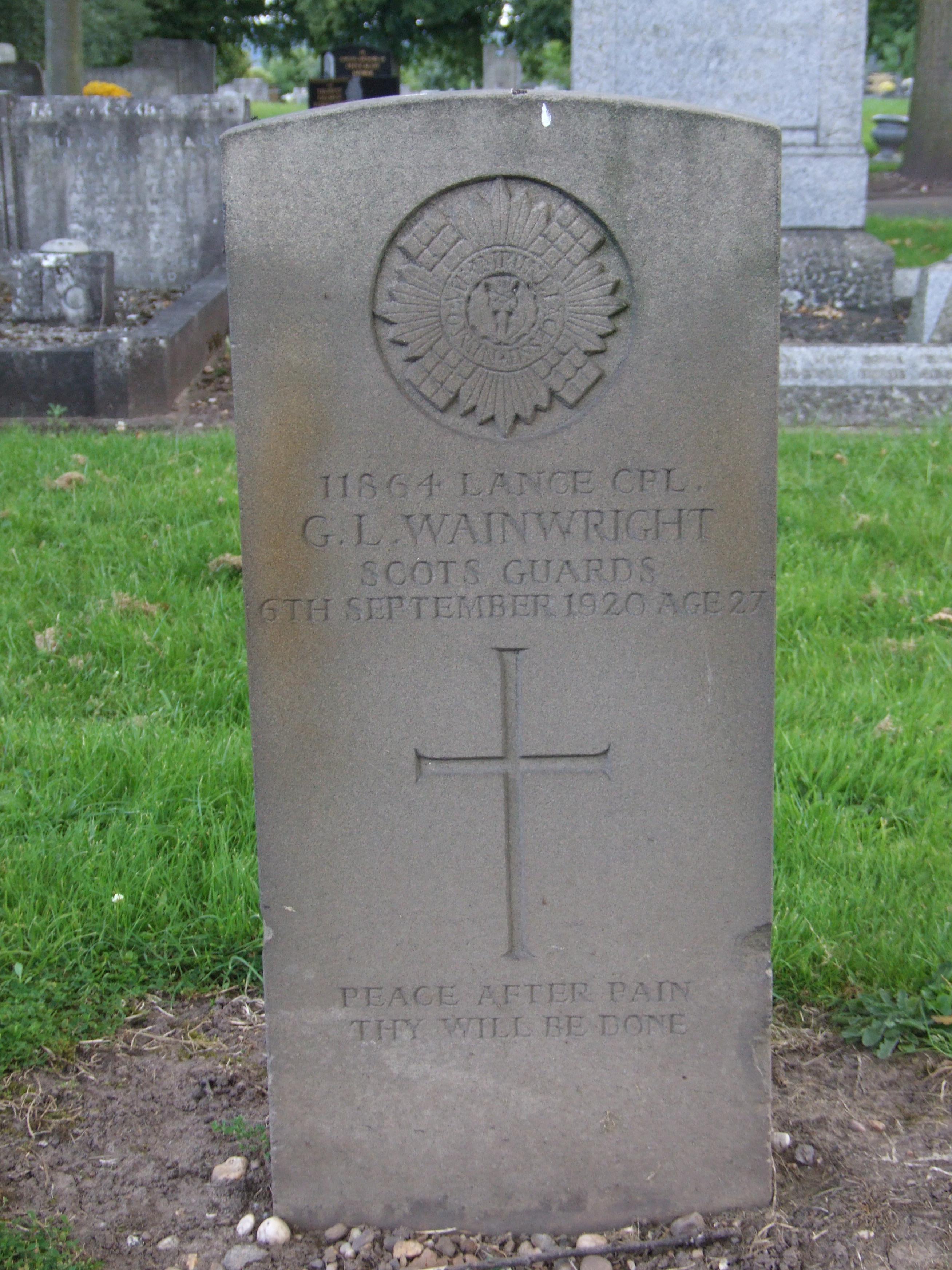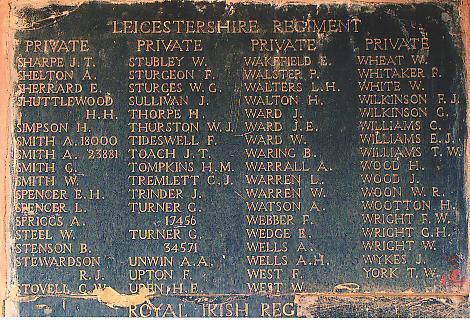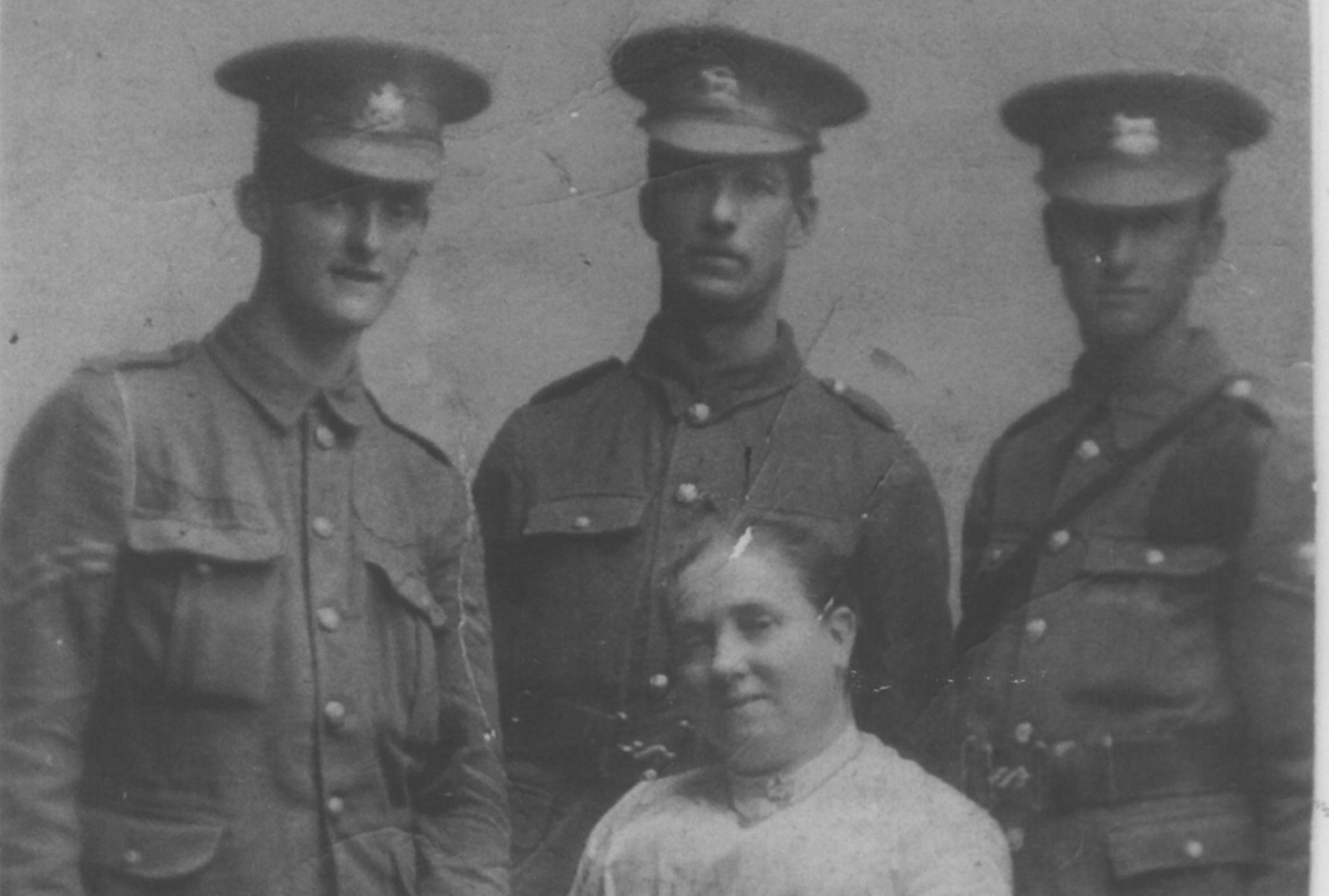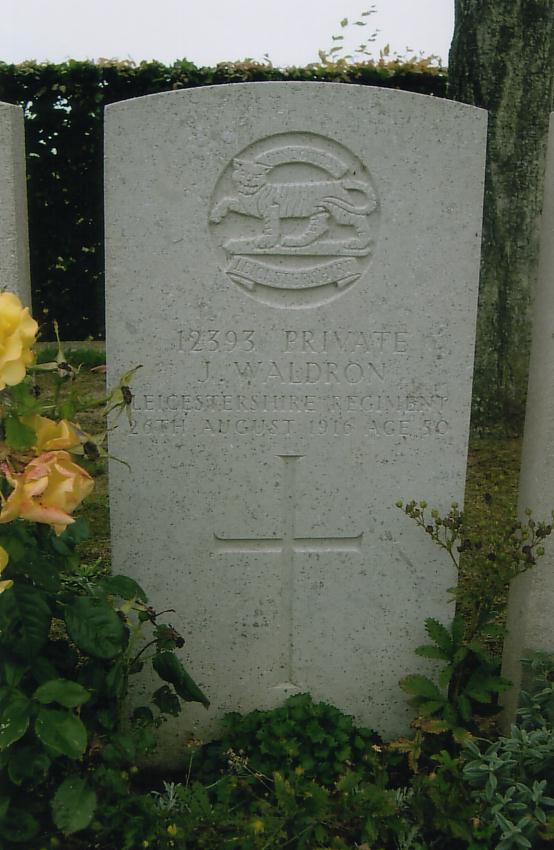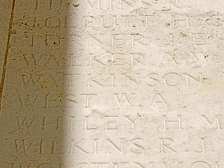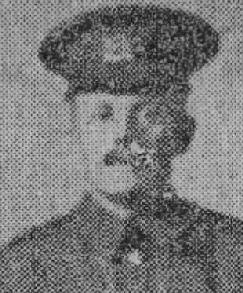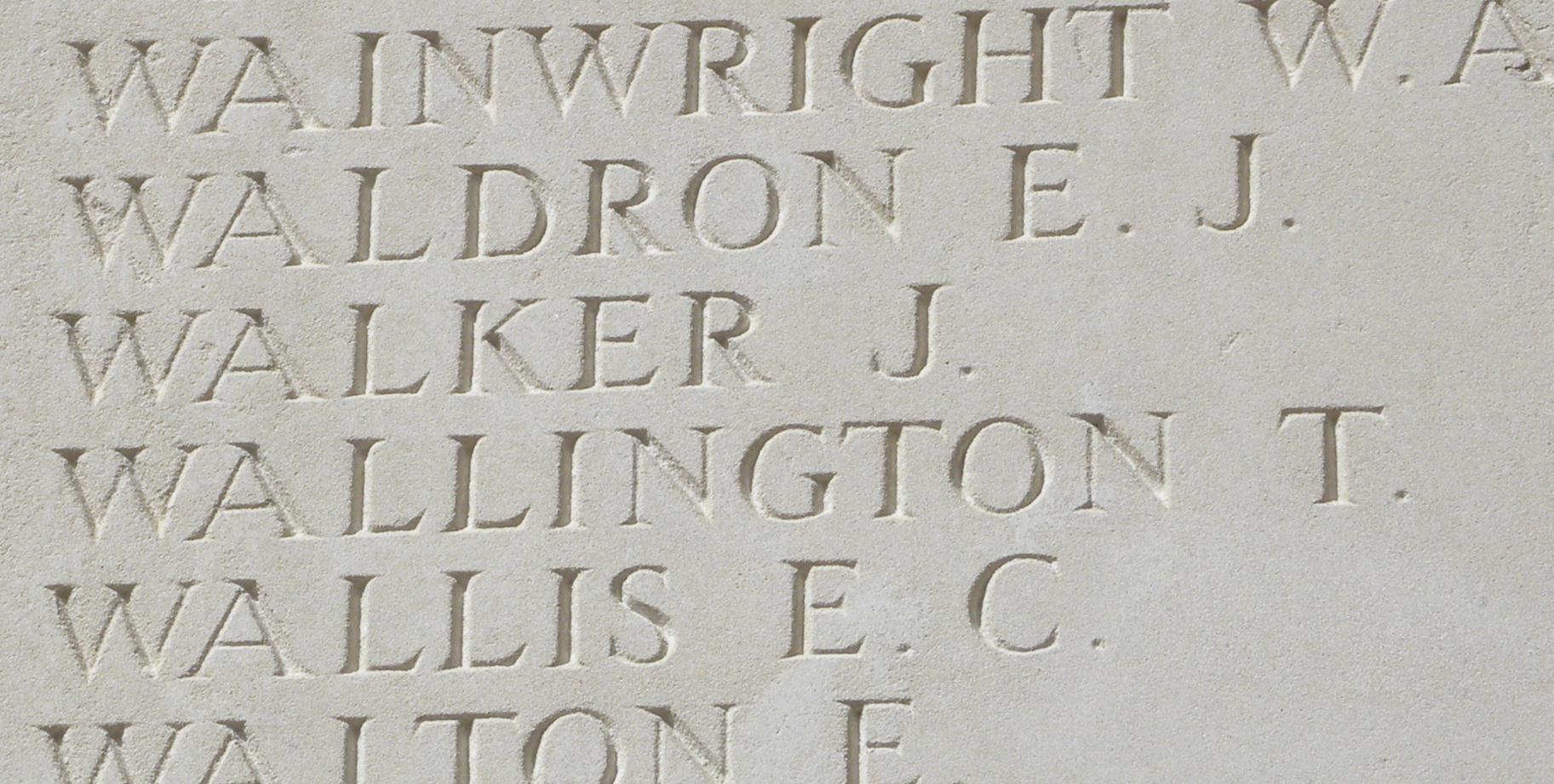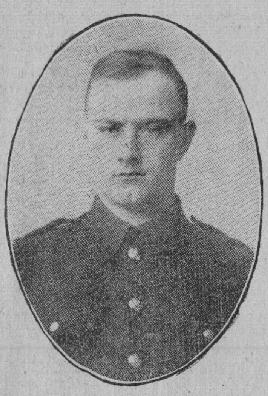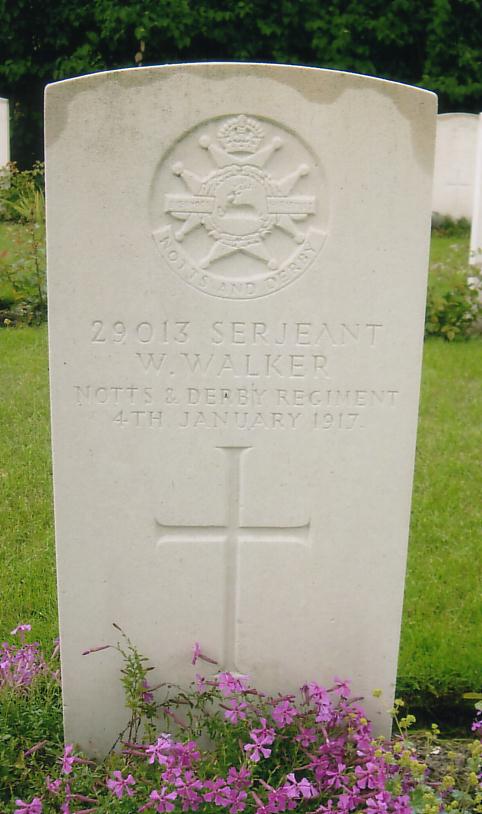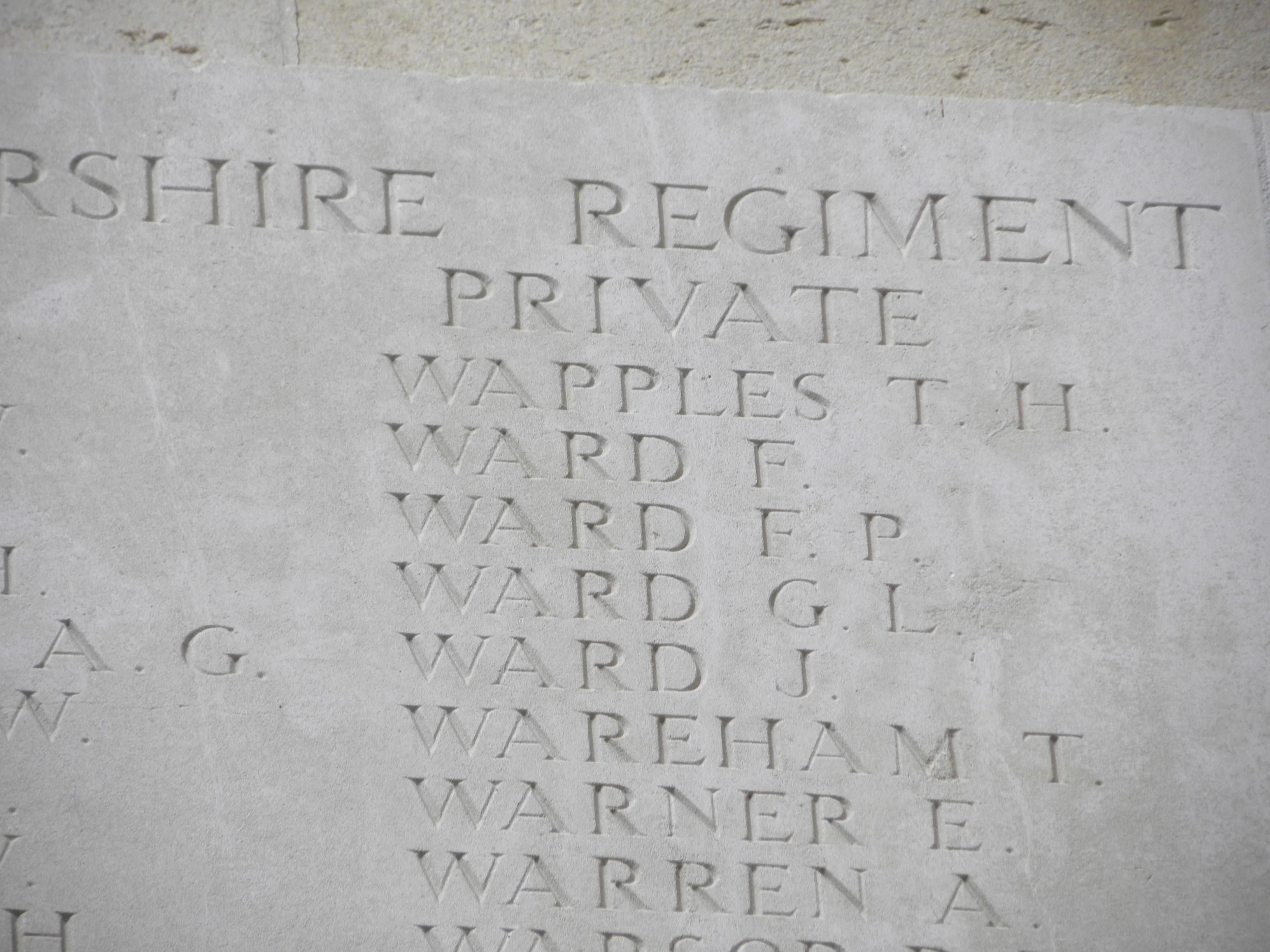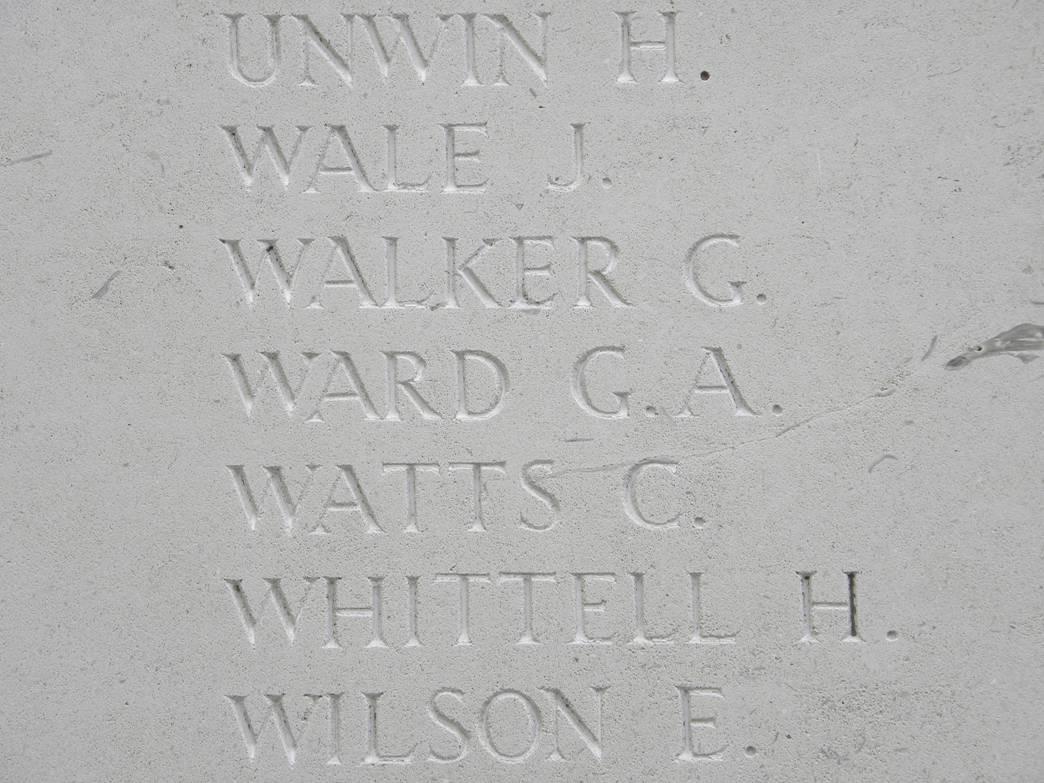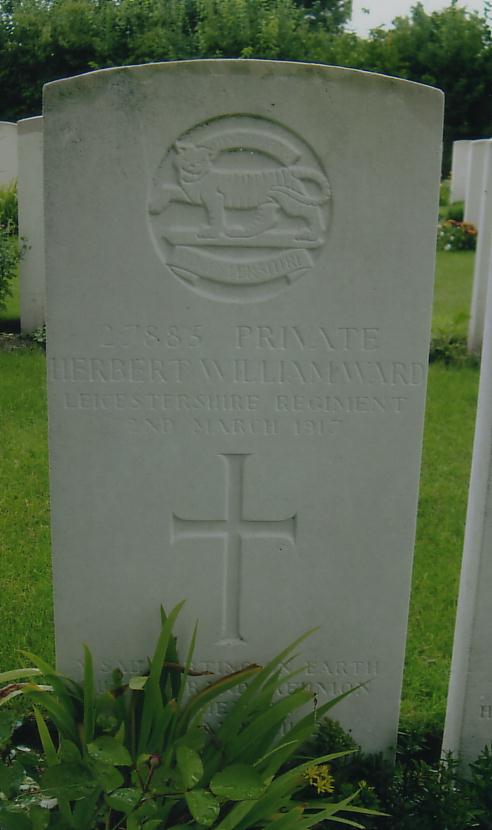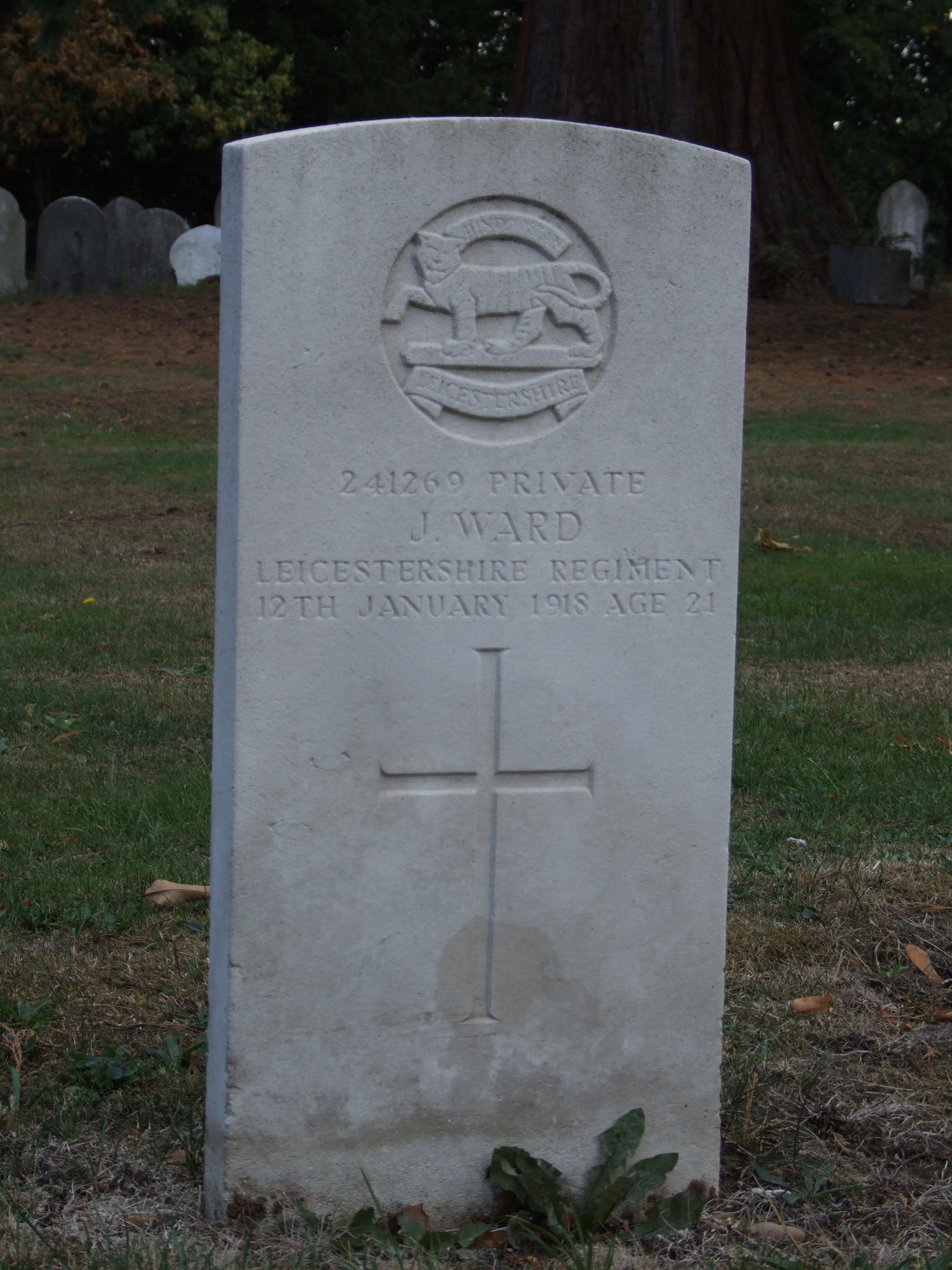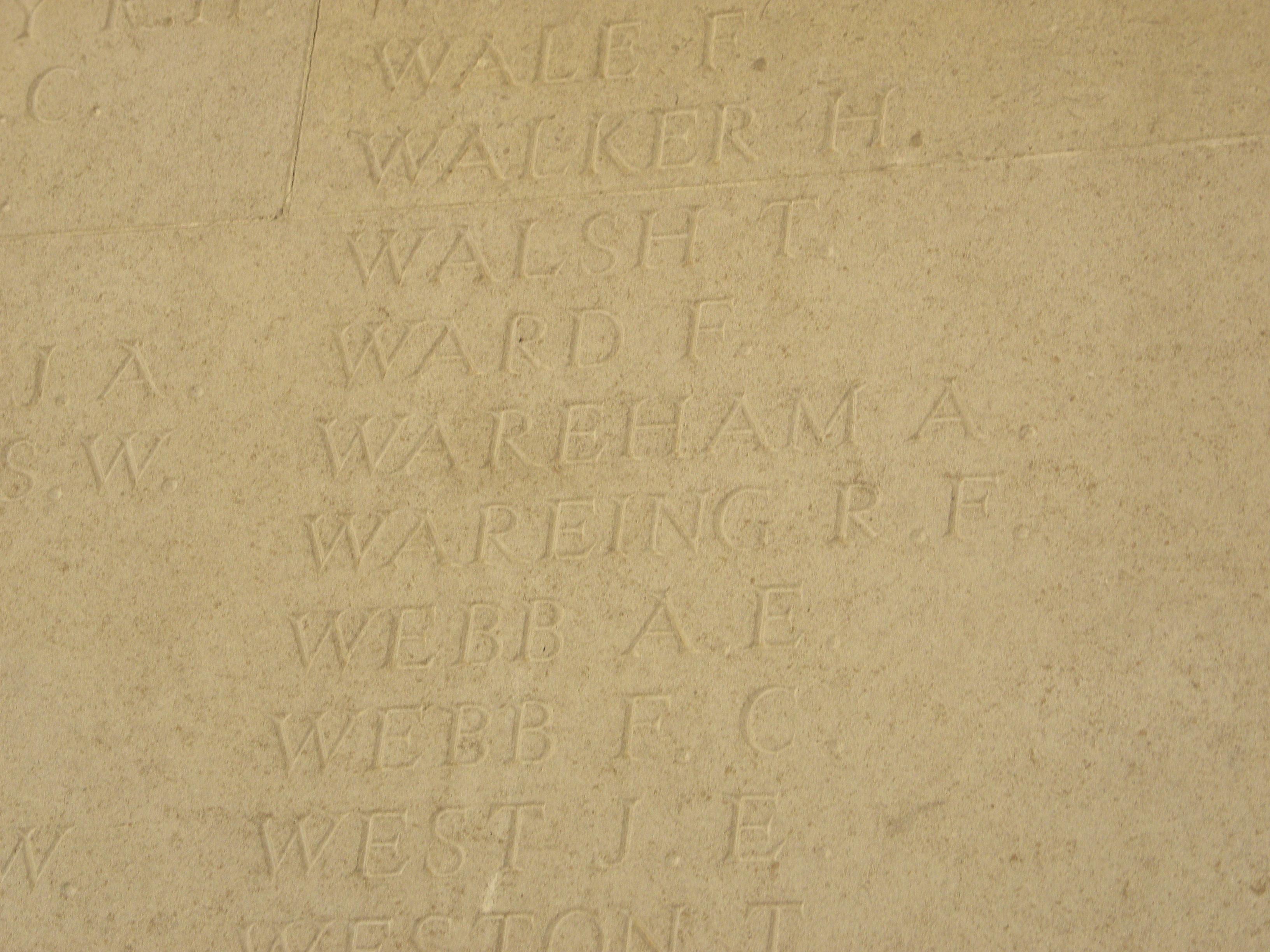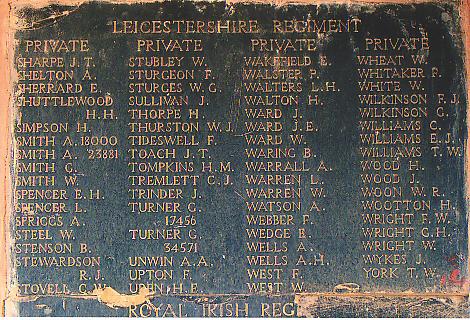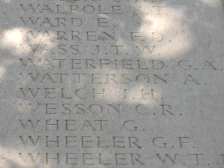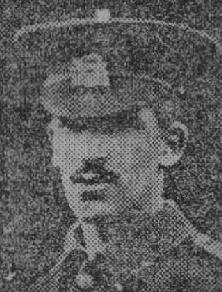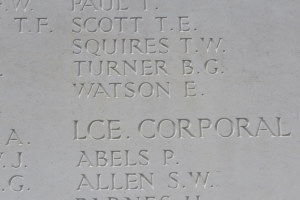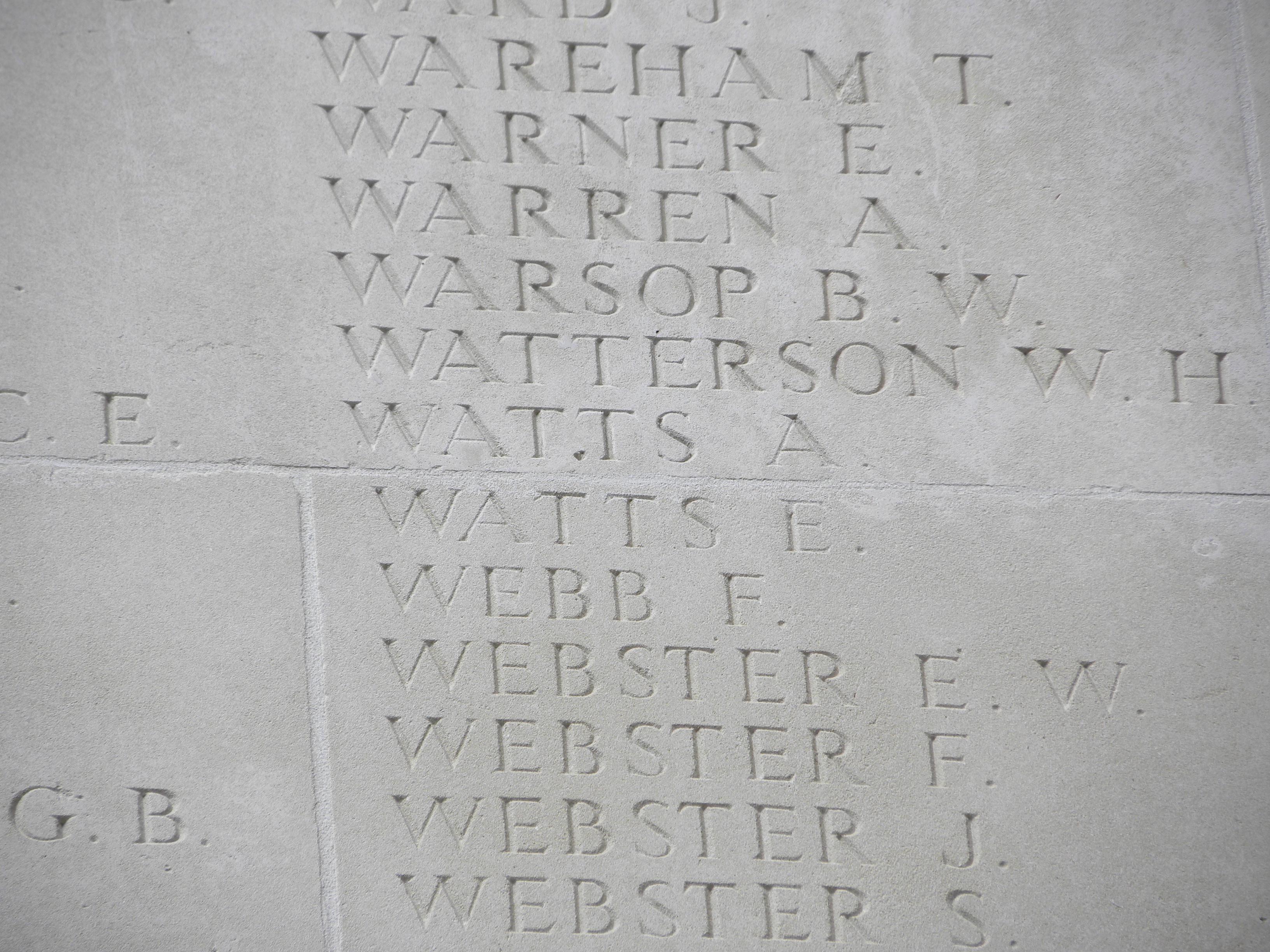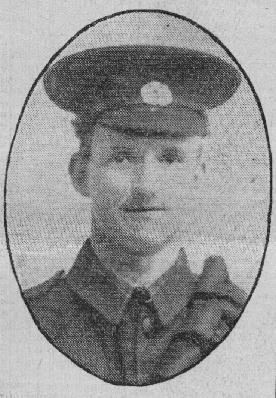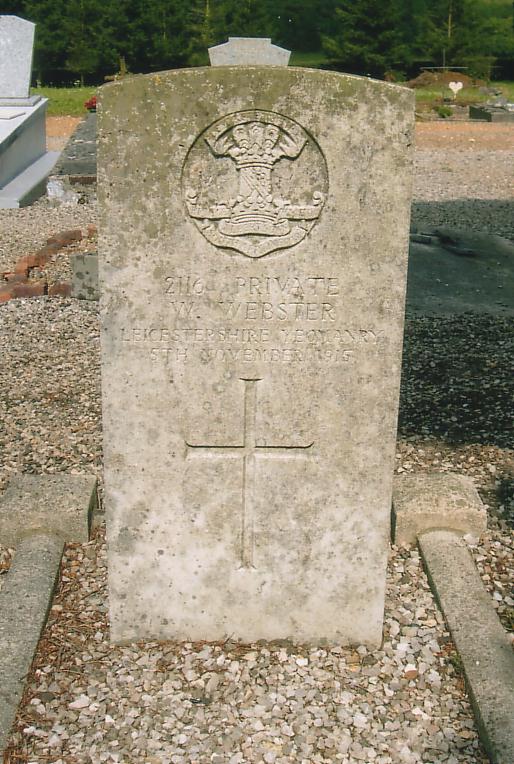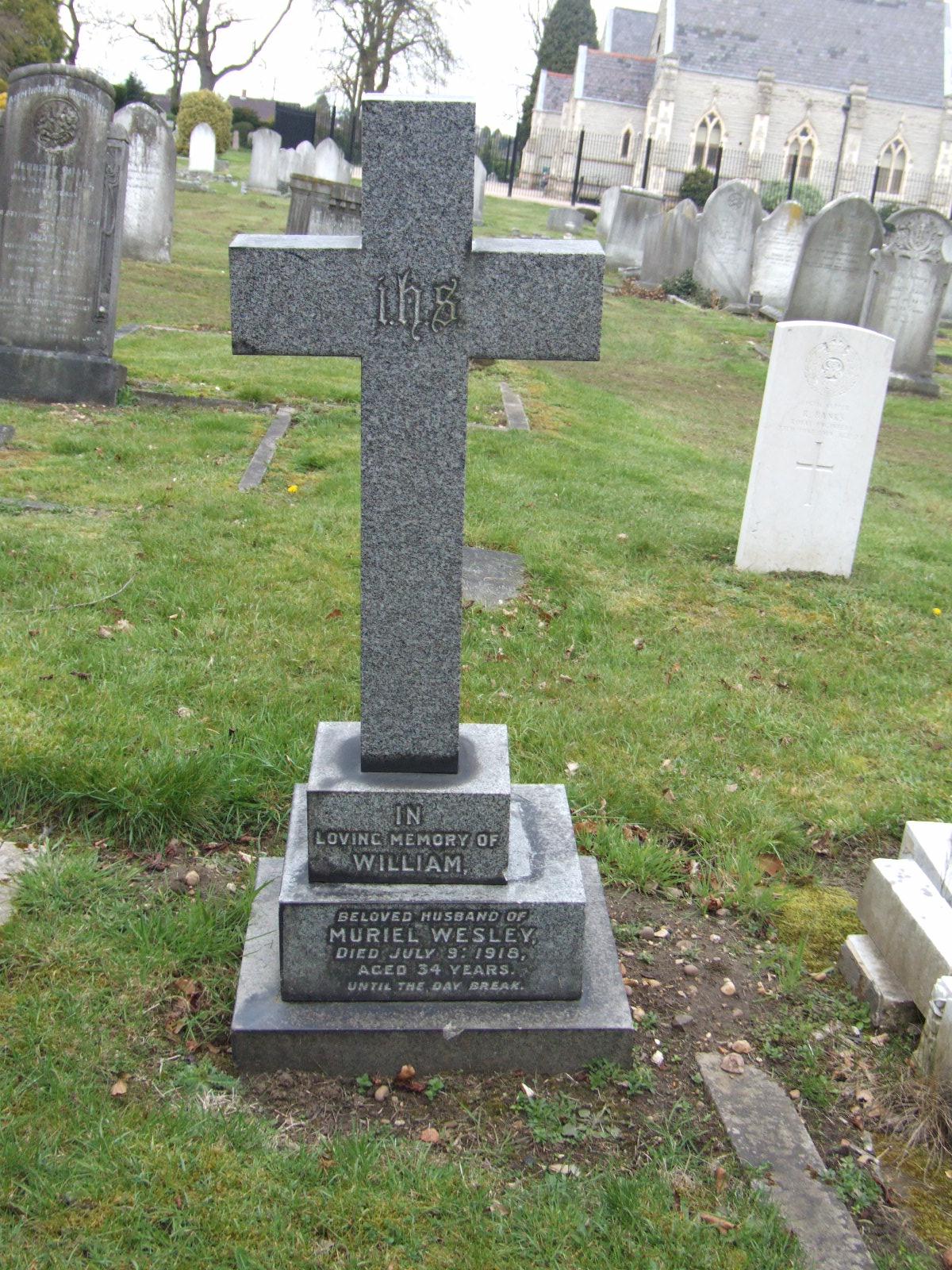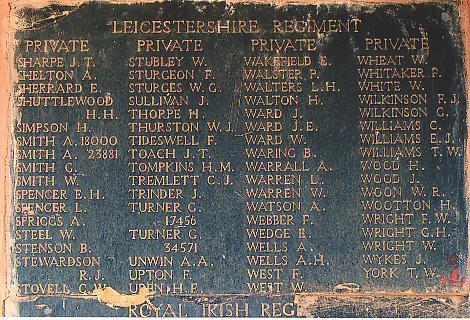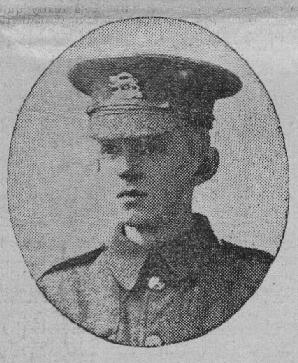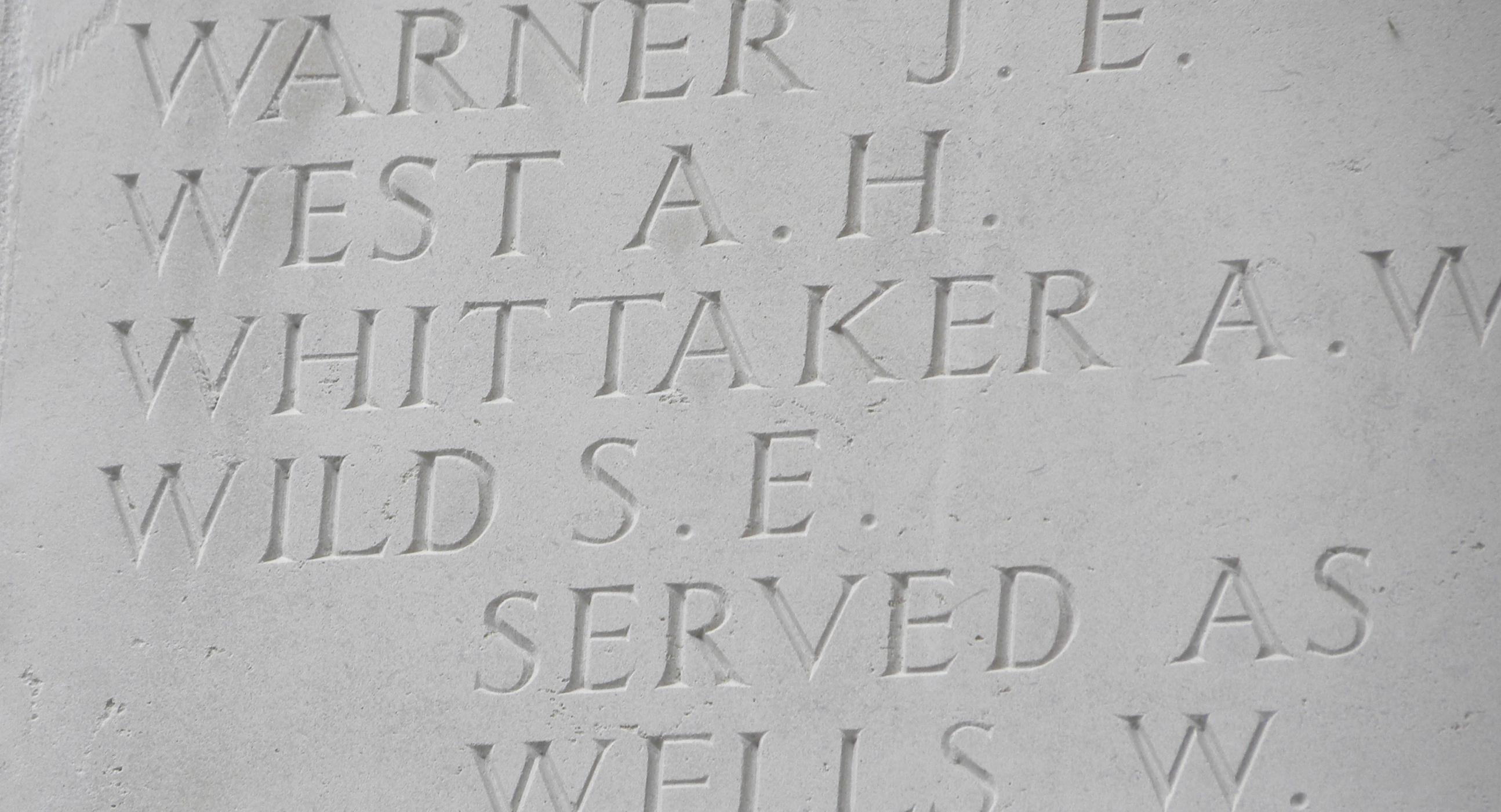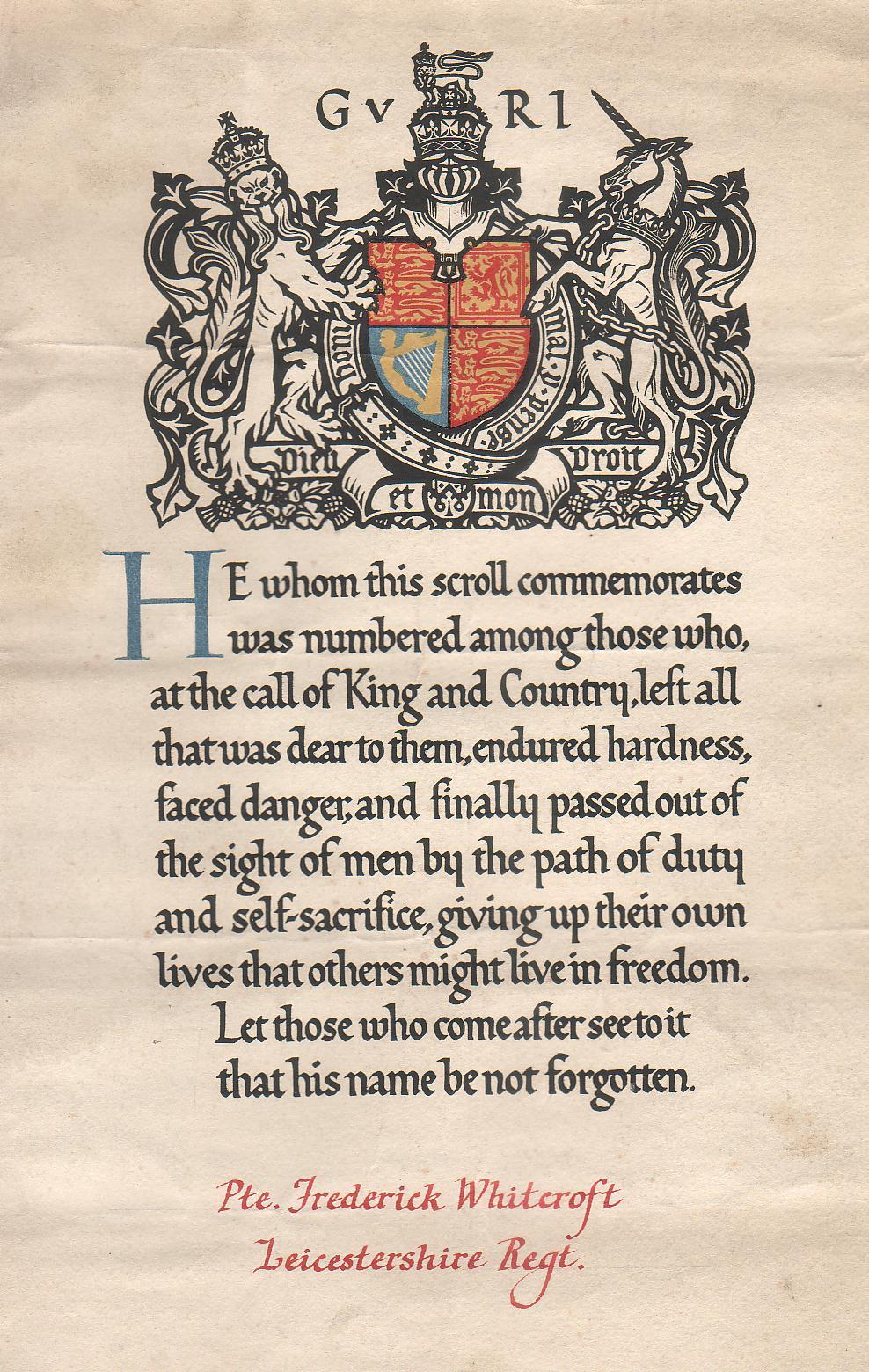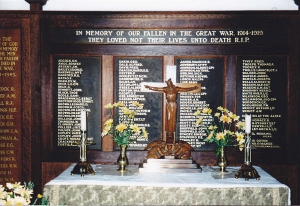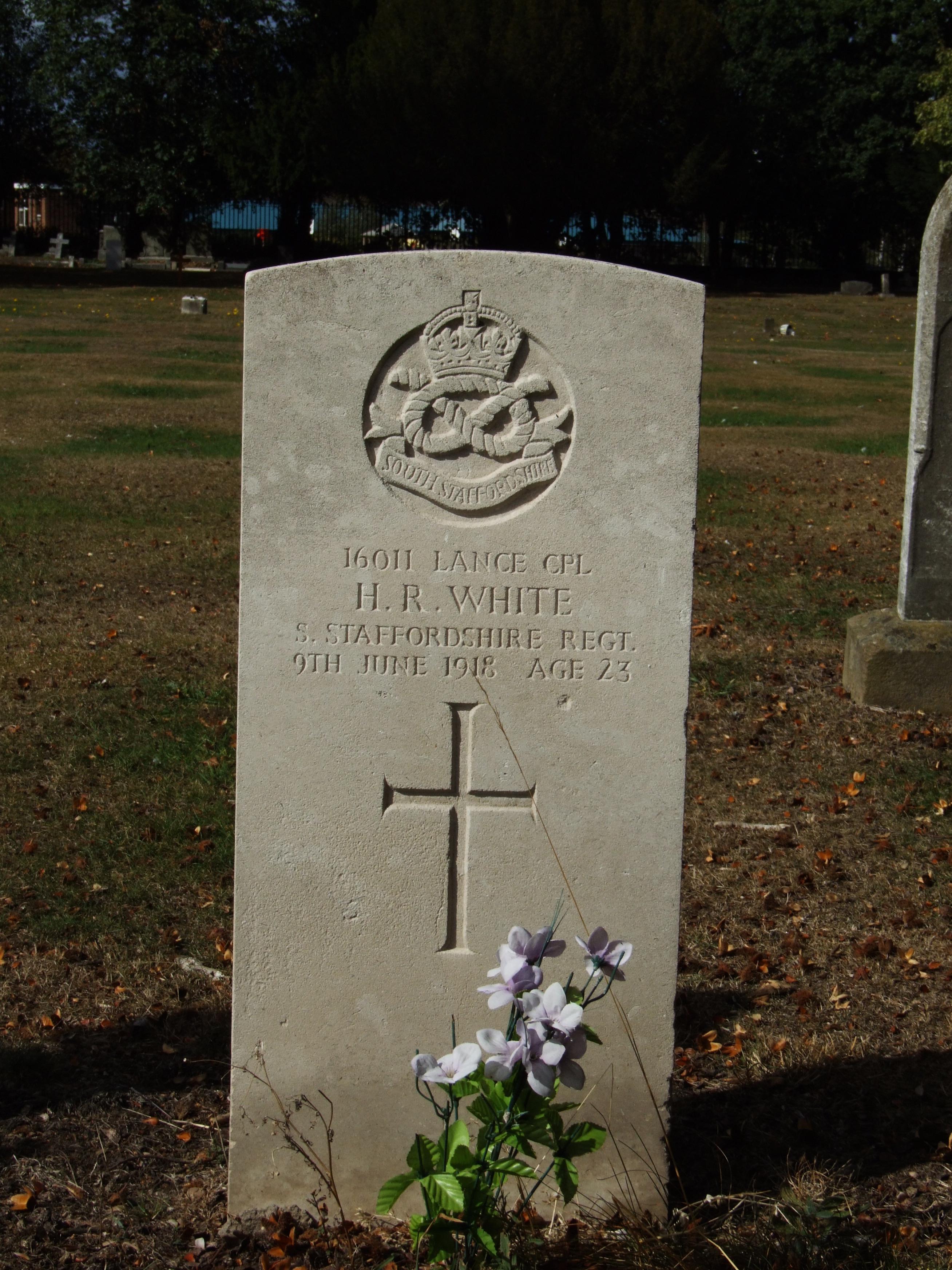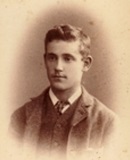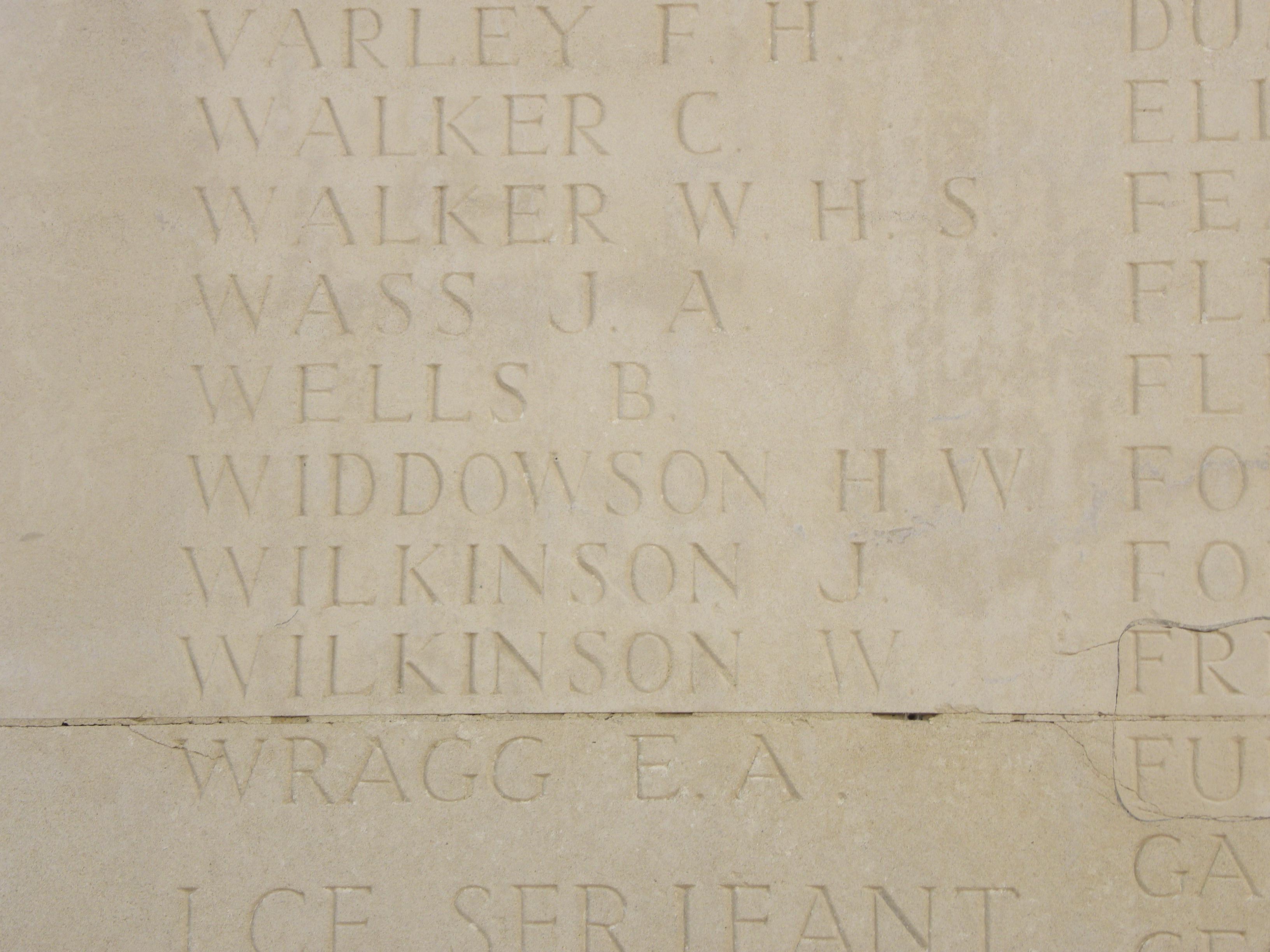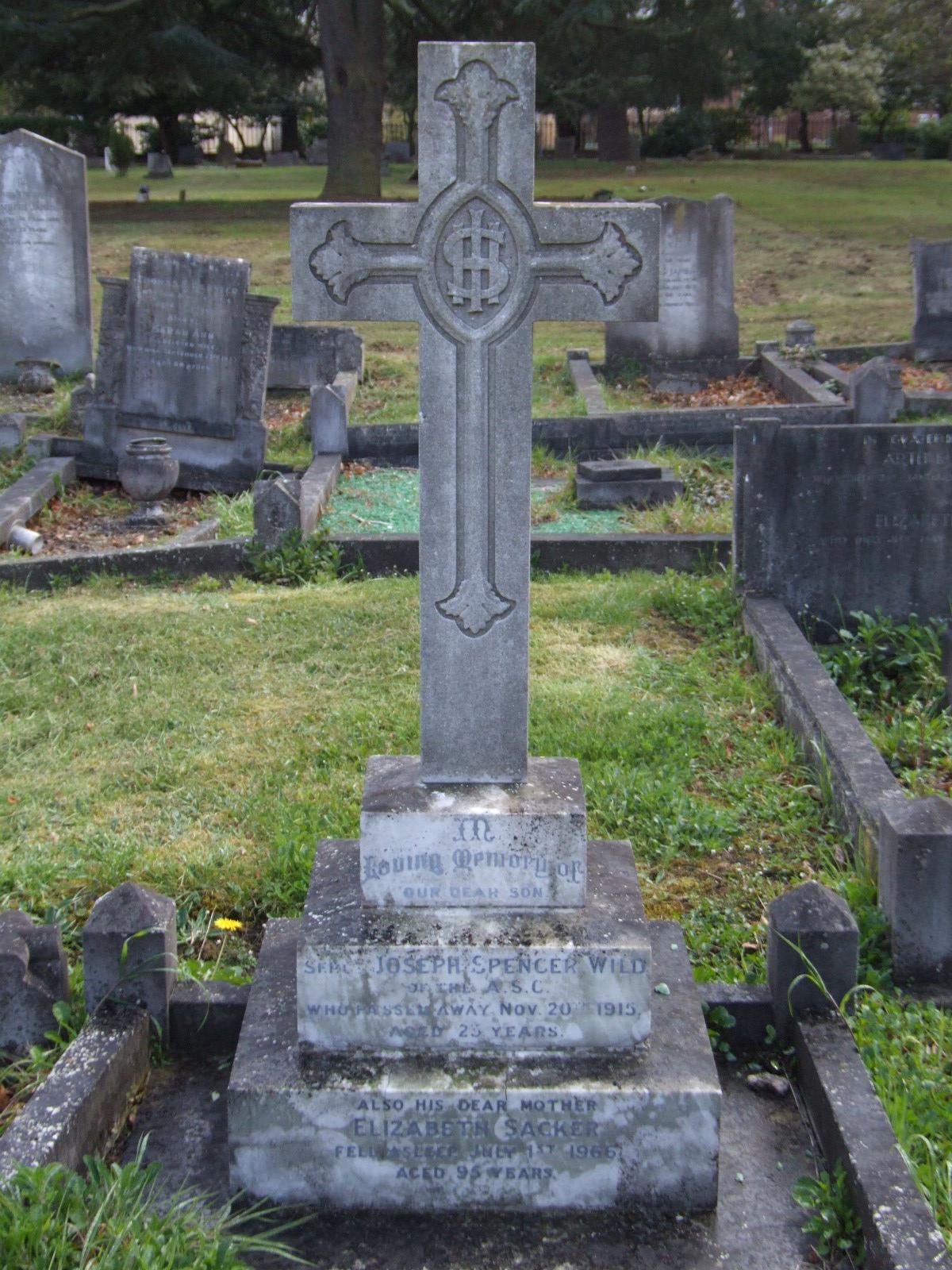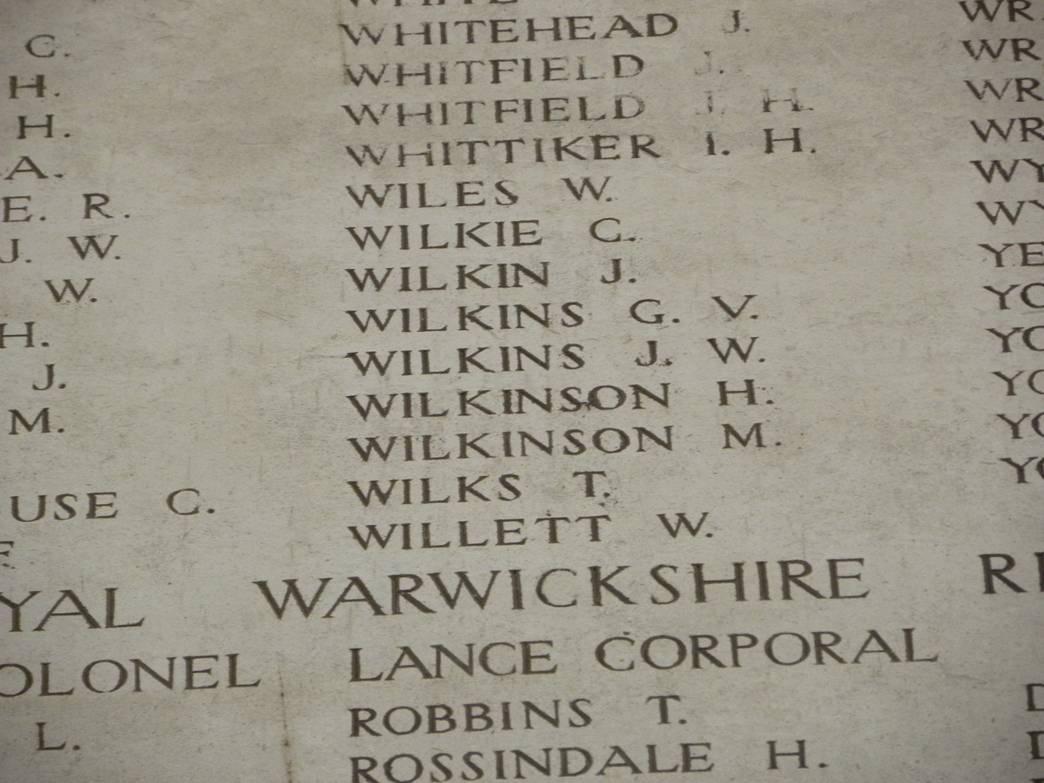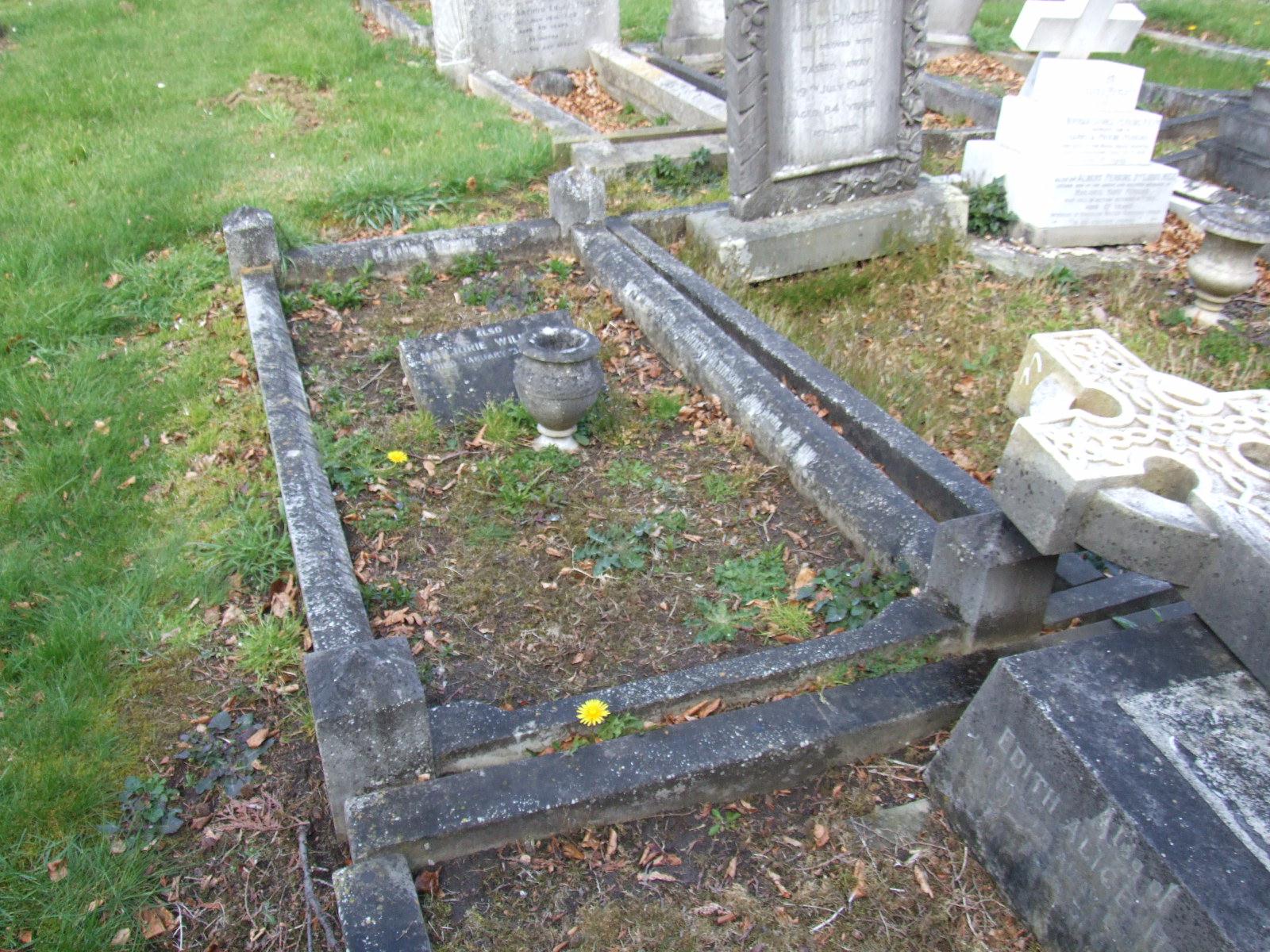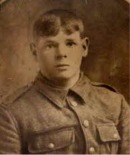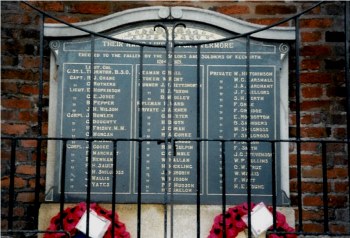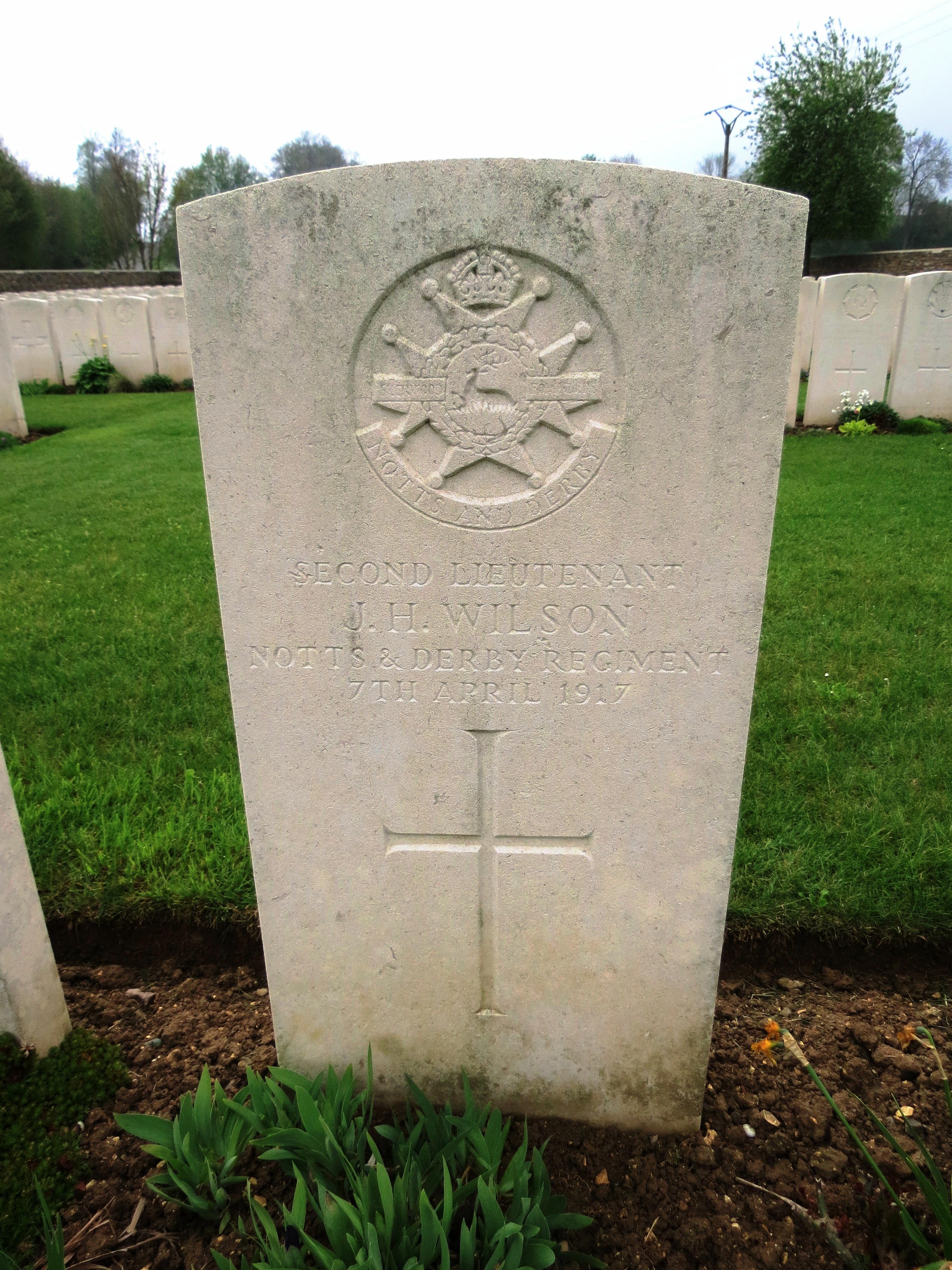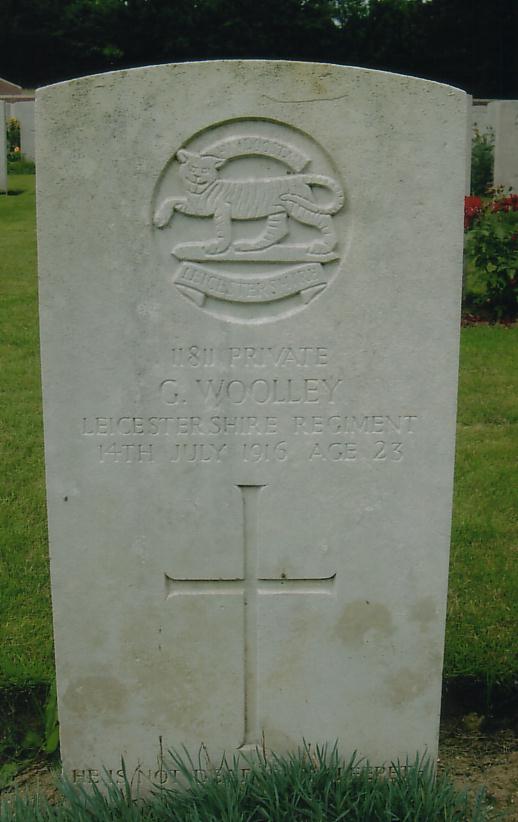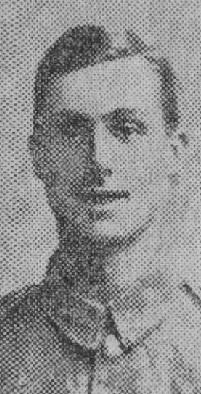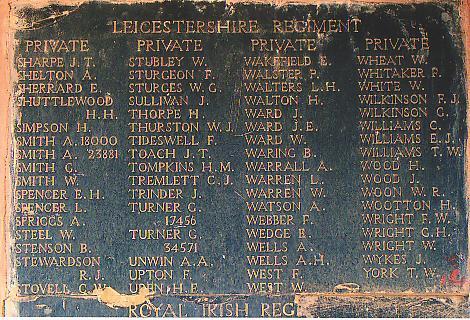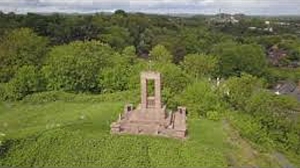|
Lance Corporal 11864 George Lawton Wainwright |
|
1st Bn, Scots Guards Died at Home 6th September 1920, Aged 27. Buried Tamworth Cemetery, Staffordshire 7800.
|
|
George Lawton Wainwright was born in late 1892 or early 1893 in Selly Oak, near Birmingham. He was the son of George Arthur Wainwright, a police sergeant, and his wife Ruth Lilian (née Lawton) who were married at St. Mary's Church, Atherstone, Warwickshire, on 4th November 1890. George Junior had one brother Cecil and one sister Irene. Another brother James died in infancy and another sister Lilian died, aged nine, in 1901.
In 1901 the family lived at 15 Police Buildings, Dudley, Worcestershire. It seems that between 1901 and 1907 George Junior's father died. His mother, meanwhile, having passed the examination of the Central Midwives Board, was placed on The Midwives' Roll on 10th October 1907. By 1910 she had moved to 80 Leicester Road, Loughborough, to be near her sister Ada Brown who lived at 44 Charles Street. She later moved to 55 Rosebery Street, then to 36 Chestnut Street, and then to 22 Boyer Street. When the 1911 census was taken George Junior's mother was living in as a nurse with the Matthews family at School House, Churchgate, Loughborough. George Junior, meanwhile, was boarding at 3 Chestnut Street, Loughborough, and was employed as a clerk at an engineering works. His sister Irene was living with her aunt Ada Brown at 44 Charles Street and his brother Cecil was living with his uncle and aunt Charles and Emma Lawton in Atherstone, Warwickshire. George Junior enlisted on 2nd November 1914 in Liverpool. At the time he was employed as a warehouseman in Birmingham. He was sent to the Scots Guards and as Private 11864 posted to the 3rd (Reserve) Battalion at Wellington Barracks, Chelsea, London. On 22nd April 1915 he was reposted to the 1st Battalion (part of the Army's First Division) and sent to France. George Junior joined his battalion at La Tombe Williot near Locon, Pas de Calais. On 24th April the battalion marched to Gonnehem and was in Corps reserve until 2nd May. A two-day trench tour at Rue du Bois followed and then four days in billets at Richebourg St. Vaast. On 9th May the battalion took part in an assault which failed before moving to billets at Hinges and Les Harisoirs. The remainder of May was taken up with three trench tours, one at Givenchy and two at Le Rutoire near Vermelles. Breaks were taken at Sailly Labourse, Noyelles and Vermelles. In early June the battalion was in billets at Béthune for ten days. After a trench tour at Quinchy and a rest at Cambrin the battalion was ordered on 16th June to proceed to Labeuvrière. Training took place there until 23rd June when the battalion marched to Verquin for further training until 5th July. The battalion then completed two trench tours at Le Rutoire, with breaks at Labourse and Vermelles. Between 19th and 25th July the battalion was at Verquin for musketry training, football and the Brigade horse show. At the end of July there was a trench tour near La Bassée. From 6th - 12th August there was training at Verquin, followed by two trench tours at Le Rutoire. On 23rd August the battalion left Noyelles in order to join up with the 2nd Guards Brigade of the Guards Division. They marched via Mollinghem and Compagne to Tatinghem where drill and training was carried out until 21st September. On 22nd September the battalion marched to Herbelle and on 23rd was ordered to join the brigade at Therouanne, taking billets at Ligny-les-Aire and Auchy-au-Bois and then at Houchin. On 26th September the battalion marched via Sailly Labourse to the old German trenches west of Loos. On 27th they marched through Loos and took up a position in trenches on Hill 70 north of the town. Here they dug in until 1st October and suffered heavy casualties, with 27 men killed, 44 wounded and 95 missing. After a short break at Vermelles the battalion moved to trenches in front of the Hohenzollern Redoubt where from 5th-13th October they were again heavily shelled by the enemy. On 15th, after bombing practice in the Bois des Montagnes near Vaudricourt, the battalion proceeded to the trenches behind the Vermelles-Auchy railway and then to the trenches opposite Hohenzollern where they repulsed an enemy attack. After returning to the railway trenches they went into billets at Annequin. On 25th October the battalion marched to Béthune, entrained for Lillers and marched to billets at Bourecq and St. Hilaire. Instruction and training took place at Bourecq until 7th November. Between 8th and 14th November the battalion was in billets at La Gorgue and then Bout Daville prior to another trench tour. On 26th November, having proceeded via Merville and La Gorgue, the battalion went into the trenches near Laventie. During December the battalion completed four trench tours near Laventie, with breaks at Merville and Riez Bailleul. The battalion enjoyed their Christmas dinner and a concert at La Gorgue on 28th December. During January 1916 the battalion did four more trench tours at Laventie. Between 13th and 26th of the month they were at billets in Merville for bombing practice, football and boxing. February began with a week's bombing and sniping practice at La Gorgue followed by two trench tours near Riez Bailleul. On 16th February the battalion began a ten day transfer to St. Jan de Biezen for bombing practice and work on the Elverdinghe defence scheme. On 5th March the battalion marched to Poperinghe, entrained for Calais and marched to a camp at Beaumaris. Here they had bomb practice and also rehearsed attack procedure. On 19th March they returned to Poperinghe for Lewis gun practice and on 25th March entrained at Poperinghe for Asylum Station, Ypres. From then until the end of May the battalion was in the trenches, firstly at the Canal Bank, Ypres, with breaks at Vlamertinghe and Camp B, and then at Potijze Wood, followed by a break at Camp K, Poperinghe. At the beginning of June George Junior, now a Lance Corporal, was taken ill. He was brought back to England on 16th June 1916 and diagnosed with valvular disease of the heart. On 19th August 1916 he was discharged from the Army as no longer physically fit for war service. George Junior stayed for a while with his mother at 36 Chestnut Street, Loughborough, but in 1917 moved to 16 Hospital Street, Tamworth, Staffordshire. He was awarded a Silver War Badge. He died in Tamworth, aged 27, on 6th September 1920 and was buried in Tamworth Cemetery, Grave 7800. |
|
Private 7376 Ernest Wakefield |
|
|
2nd Bn, Leicestershire Regiment. Killed in Action 8th March 1916, Aged 29. Commemorated Basra Memorial panel 12.
|
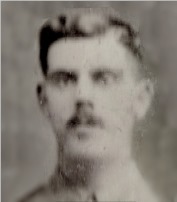 |
|
Ernest Wakefield was born in Bottesford, Leicestershire, on 28th August 1886. He was the son of Thomas Wakefield a garden labourer from Colsterworth, Lincolnshire, and Sarah Ann Wakefield (née Tinkler) from Muston, Leicestershire. Thomas and Sarah had married in 1883 in the Grantham district and they had three sons: John William, Ernest and Walter. |
|
|
Private 7079 Arthur Sampey Walker |
|
|
1st Bn, Leicestershire Regiment. Killed in Action 7th November 1914, Aged 42. Commemorated Ploegsteert Memorial, panel 4.
|
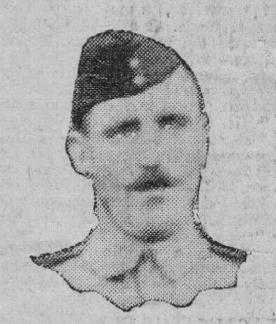 |
|
Arthur Sampey Walker was born 'Arthur Sampey' in around 1873, probably in Lincoln. He was the son of John Sampey, a pedlar, and his wife Hannah (née Murphy) who were married in Boston, Lincolnshire, in 1859. Arthur had three brothers John James, William and Martin and three sisters Mary Ann, Sarah and Cicely. Between 1869 and 1876 the family lived in various locations around Lincolnshire, the parents sometimes placing the children in various lodgings while they were on the road carrying out their hawking business.
In 1858 Arthur's father, who also used the alias of 'John Brown', was sent to Spilsby Prison for one month for hawking without a licence. In 1867 Arthur's mother was fined for stealing cabbages from a field in Heighington. In October 1876 a tragedy hit the family. Arthur's father accidentally drowned in the Great Ouse river at St. Ives, Huntingdonshire. This event appears to have fractured the family as by 1881 Arthur's sisters Sarah and Cecily were in the Lincoln Workhouse and the whereabouts of their mother and the other children is unrecorded. On 18th February 1895 Arthur's mother was married to Alfred Walker, a widower and horsekeeper and hawker, at St. Philip's Church, Manchester. Alfred Walker unfortunately died four years later. On 1st September 1903 Arthur attested to join the Army. He joined the Leicestershire Regiment using the name 'Arthur Sampey Walker' and stated that he was a labourer. He was sent to the Depot of the regiment at Glen Parva as Private 7070 where he stayed until early February 1905. On 18th February 1905 he was posted to the 1st Battalion and sent to Fort St. George, Madras, India. On 16th October 1906 he was transferred to the 2nd Battalion and he remained in India serving at Madras, Belgaum, Delhi, Bareilly and Ranikhet until 1st November 1911. In 1909 he attended an Ambulance Class and in 1910 it was noted that he was very good at nursing duties. On 2nd November 1911 Arthur returned to England and was transferred to Army Reserve. He found employment on the Midland Railway and moved to Queen's Road, Loughborough. When war broke out Arthur, a reservist, was recalled by the Leicestershire Regiment and on 5th August was posted to 1st Battalion which was stationed in Fermoy, Ireland. On 19th August the battalion moved to Cambridge. Arthur went with the British Expeditionary Force to France on 9th September 1914, landing at St. Nazaire, Brittany, on the following day. From St. Nazaire the battalion travelled by train to Mortcerf, east of Paris, arriving early in the morning of 13th September and then began a long march to the British Army in the line at Courcelles, on far side of the Aisne. On 14th September the 1st Leicesters relieved the Worcesters and Royal Irish Rifles in the trenches at La Fosse Marguel where they came under constant shell fire and sniping until they in turn were relieved on 12th October by 106th French Infantry Regiment. On 13th October the Battalion entrained at Fismes, 40 men crammed to each horse box. Some slept on the roof, although it was bitterly cold. They detrained on 17th October at Cassel and marched to take up defensive positions at Croix Blanche. From there, on 15th October - the day on which the First Battle of Ypres began - they marched to Rue de Bois, Armentières, and Bois Grenier, Arthur, aged 42, was killed in action on 7th November 1914 during the 1st Battle of Ypres. The battalion's war diary for 7th November records that it was quiet until about 3.30pm, when a heavy enemy bombardment was opened on 'C' Company trenches. Casualties were four men killed and six wounded. Arthur was one of those killed. Arthur is commemorated on the Ploegsteert Memorial, Panel 4. Arthur's eldest brother John James lived in Nottingham and Arthur is recorded on the Nottinghamshire County Council electronic Roll of Honour. |
|
|
Private 241135 Arthur William Walker |
|
1/4th Bn, Leicestershire Regiment. Killed in Action 17th October 1918, Aged 20. Commemorated Vis-en-Artois Memorial, panel 5.
|
|
Arthur William Walker was born in Gainsborough, Lincolnshire, in 1898 and baptised on 14th July 1898 at St. Michael's Church, Gainsborough. He was the son of Robert Walker and his wife Clara Emily (née Guy) who were married on 22nd May 1893 at All Hallows Church, Ordsall, near Retford, Nottinghamshire. When Arthur was born the family was living at 9 Beaufort Street, Gainsborough, but by 1899 they had moved to 15 Wharncliffe Road, Loughborough. In 1911 the family was living at 16 Warner Place and later moved to 77 Russell Street. Arthur's father was a foreman platelayer on the Great Central Railway. Arthur had three brothers Cyril, Herbert and Ernest.
Arthur enlisted with the 2/5th (Territorial) Battalion of the Leicestershire Regiment as Private 3380, later being renumbered as 241135. The exact date of his enlistment is unknown as his service papers have not survived but it may have been in the spring or summer of 1916.The 2/5th Battalion had its HQ in Loughborough as part of the Lincoln and Leicester Brigade, North Midland Division. In January 1916 parties of officers from the 2/5th Battalion were sent to France on tours of instruction in the trenches and in March, the long awaited orders to proceed overseas were received. On Easter Monday, however, the rebellion in Ireland forced a rapid change of plans. The 177th Brigade was recalled from leave and ordered to move to Liverpool at midnight. The following day they sailed on the SS Ulster, a fast mailboat, escorted by a Royal Navy destroyer. Their first taste of action was not to be in the trenches of the Western Front, but in the streets of Dublin. By the end of the month the main uprising was over and the 2/5th Battalion supplied search parties for Ballsbridge and guarded railways, bridges and other key infrastructure. On the 10th May they moved out of the city to tackle pockets of resistance in County Kerry, searching homes and making arrests. In June word was received that the Battalion would be moving to France and training resumed with long route marches through Ireland. In August they marched 80 miles from Tralee to Fermoy Barracks, where they would remain until January 1917, engaged in live fire training in trench warfare. The length of time that Arthur may have spent in Ireland with the 2/5th Battalion is unknown. The return trip from Ireland was made aboard the SS Ulster and the battalion arrived at Fovant Camp in Wiltshire by train at 7pm on 6th January 1917.After embarkation leave the battalion proceeded to France via Southampton, arriving at Le Havre on the 24th February 1917. They were sent to the Somme area where the enemy was retreating to the Hindenburg Line. They made their first attack on the villages of Hesbecourt and Hervilly on 31st of March 1917, capturing both villages and suffering a number of casualties. On 1st April the battalion began constructing a line of cruciform posts and on the following day were shelled while doing so. On 3rd and 4th April part of the battalion supported the 4th Leicesters in an attack on Fervaque Farm while the rest of the battalion built posts in Templeux. On 11th and 12th April the battalion moved to Hervilly and Hamelet to provide working parties and on 15th A and C Coys were in support for an attack on Villeret. On 17th April the battalion moved from Brosse Woods to Templeux and Hervilly and were in support again on the following day in an attack on a quarry north of Villeret. On 19th April the battalion moved to Hancourt for cleaning up, working parties and training. On the night of 27th/28th April Hancourt was bombarded by the enemy and the battalion moved to the front line at Le Vergier. Trench tours continued until 15th May when the battalion marched back to Bois Bias training camp between Bouvincourt-en-Vermandois and Le Catelet. Training took place until 25th May when they moved to Equancourt and went into the front and support lines at Villers Plouich. Here until 7th June more posts were constructed amid some heavy enemy bombardment. From 7th-16th June the battalion was in Brigade Reserve at Dessart Wood, after which the battalion returned to the front line at Villers Plouich and carried out cable digging and laying for the Royal Engineers. Attack training took place at Equancourt from 22nd-30th June, after which the battalion went into support at Metz-en-Couture until 10th July. For the rest of July and the first three weeks of August the battalion was in training at Barastre camp. On 22nd August the battalion moved via Senlis to a front one mile south-west of Le Sars for further training. On 31st August they entrained at Albert for Hazebrouck and marched to a training camp north of Winnezeele where they remained until 20th September. By 23rd September the battalion was in the reserve trenches at St. Jean near Ypres, before taking over the front line at Hill 37, Hill 35 and Elmtree Corner. On 26th September the battalion went into attack to capture all enemy positions on Hill 37 (part of the Battle of Polygon Wood, a phase in the 3rd Battle of Ypres or Passchendaele). All objectives were taken and on 30th September the battalion proceeded to Corps reserve on the Wieltje road and then to Vlamertinghe. On 2nd October the battalion travelled by train to Thiennes and then spent three days at the Training Base Depot, Calais. On 6th October they moved by bus to Beaumetz-lez-Aire for a further three days training. Between 10th and 13th October the battalion marched via Camblain-Chatelain and Houdain to Gouy-Servins. After a brief halt at Tottenham Camp they began a trench tour at Old Brewery. Training and inspections took place at Alberta Camp from 21st-28th October before the battalion returned to the line at Liévin. Early November was occupied with working parties before the battalion moved by light railway and march to Petit Servins for training. Between 17th and 21st November the battalion marched via Habarcq and Bailleulval to Henman Camp South, Achiet-le-Petit. Two days later they entrained for Fins and marched to Dessart Wood. On 30th November they moved forward into the Hindenburg Support line. On 4th December the battalion withdrew to hold the Flesquières line. Between 6th and 9th December the enemy attacked in large numbers but were repulsed and there was heavy shelling with artillery duels on both sides. The next part of December was spent training at Lechelle, in Reserve at Trescault, and on working parties in the Hindenburg support line. On 23rd December the battalion marched to Rocquigny. On Christmas Day they entrained at Bapaume for Tinques and marched to Penin. Christmas was celebrated on 27th December, after which training began and continued throughout January 1918. On 31st January 1918 the 2/5th Battalion was broken up and the men distributed between the 1/4th, 2/4th and 1/5th Leicestershire battalions. Between 158 and 200 Ordinary Ranks (accounts vary) were posted to the 1/4th Battalion at Mont Bernachon and it is likely that Arthur was in this group. On 1st February the 1/4th Battalion marched to Busnes. Training and reorganisation took place at Busnes until 8th February when the battalion marched to Westrehem. The battalion was now ordered to seize the crossing of the River Lys between Delette and Dennebroeucq. This was done and the battalion moved to Coyecque to continue training until 1st March. On 1st March the battalion began a four-day move via Flechin, Manqueville and Noeux-les-Mines to the trenches in the Cambrin south sector. On 7th March they shot down an enemy propaganda balloon which contained a copy of Gazette des Ardennes. Several days in Brigade support at Annequin and Sailly-Labourse followed when the men provided working parties. After this there was a return to the trenches in the Cambrin north sector where they were shelled by the enemy. Following a break at Beuvry the battalion went into the front line in the Hohenzollern sector. Here they were heavily trench-mortared by the enemy who endeavoured to break through the front. As the enemy was now expected to attack between Hill 70 and La Bassée the battalion was ordered to move to the Hill 70 sector. Relieved on 6th April the battalion moved to Les Brebis for a rest and to provide working parties. Returning to brigade support on 9th April the battalion suffered an enemy gas attack. After a brief return to the front line the battalion was relieved on 12th April and began a three-day move to Bois de Froissart Camp, Hersin, where a large number of men were sent to hospital suffering from influenza. On 26th April the battalion marched to Fouquières and into brigade support near Essars which was shelled on 29th and 30th April. During the night of the 2nd/3rd May 1918 the battalion relieved the 5th Lincolnshires in the left sub-sector of Essars. On 4th May the enemy put down a heavy barrage on the left company front. On 6th May the battalion was relieved and marched to Vaudricourt. During the rest of May there were two trench tours in the Gorre sector, with breaks at Vaudricourt. From June to August there were trench tours at Essars and Gorre as well as salvage work, a ceremonial parade at Vaudricourt Park and a sports and horse show. By 26th August there were signs that the enemy was withdrawing and the battalion began to push forward north-west of Le Touret. Between 5th and 10th September the battalion was in training at Fouquières. On 12th they entrained at Chocques for Méricourt l'Abbé where training continued until 17th. The next move was to Tertry and into the line west of Pike Wood where the battalion was badly bombed by hostile planes. The battalion subsequently carried out successful attacks on Pike Wood, Bellenglise and Magny-la-Fosse. On 3rd October the battalion took part in a divisional attack on Ramicourt and Montbrehain. After moving to the west side of the St. Quentin Canal they advanced to hold a line north-east of Fresnoy. The advance continued to the south-west of Riquerval. On 16th October, after a couple of days training for another attack the battalion took up positions in Valley Hassard. During the attack on 17th October 1918 Arthur, aged 20, was killed in action. Arthur is commemorated on the Vis-en-Artois Memorial, Panel 5. |
|
Private 15986 Percy Wall |
|
1/6th Bn, South Staffordshire Regiment. Died 8th November 1918, Aged 30. Buried Les Baraques Military Cemetery, Sangatte, Calais, VI. E. 8A.
|
|
Percy Wall was born in Loughborough in late 1887 or early 1888 and baptised at All Saints Church, Thorpe Acre, on 24th August 1891. He was the son of William Wall and his wife Mary Ann (née Brewin) who were married at Emmanuel Church, Loughborough, on 26th January 1884. Percy's father was a carter in 1891 but later became a general labourer. Percy had two brothers John and William and two sisters Florence and Blanche. Another brother Theophilus died, aged 5, in 1899. In 1891 the Wall family lived at 8 Cradock Street, Loughborough, but by 1901 had moved to 51 Rosebery Street.
In late 1910 Percy, who was a general labourer at an electrical works, married Emma Pratt in Loughborough. Just before he was married Percy was charged with stealing cultivated mushrooms from Mr. A. F. Staniland and was fined 15 shillings and costs at Loughborough Petty Sessions. After their marriage Percy and Emma initially lived at 29A Regent Street, Loughborough but then moved to Union Street. They had two sons William and Percy and a daughter Emma. Another son John died in infancy. In 1911 Percy was fined 15 shillings for being drunk and disorderly in the Cattle Market and in July 1912 fined another 15 shillings for using obscene language in Bedford Square. In October 1912 he was charged on remand for supposedly stealing a bicycle from Fred Price of Melton Mowbray for whom he was working at the time. The court, however, gave Percy the benefit of the doubt when he said he had only borrowed the bicycle and just fined him costs. Percy enlisted soon after war broke out and joined the South Staffordshire Regiment as Private 15986. He was sent for training in Saffron Walden, Essex, and dispatched to France to join the 1/6th Battalion on 24th August 1915. He arrived in the Ypres Salient just as the battalion finished a trench tour at Hill 60 and moved to Canada Camp. In September the 1/6th Battalion spent a week in Brigade reserve at Zillebeke, completed two more trench tours at Hill 60 and also provided digging parties for the Royal Engineers. On 2nd October the battalion marched to Abeele, entrained for Fouquereuil, and marched to Robecq for two days drill and training. Instruction continued at Vaudricourt and included practice in marching over open ground in fighting order. On 12th October the men went into the assembly trenches north-east of Vermelles and on 13th October were ordered to take part in the capture of the Hohenzollern Redoubt and Fosse 8. After the initial attack failed the battalion was withdrawn to Sailly Labourse and then Vaudricourt before being sent to Allouagne and Fouquereuil for further training. Training continued for the first two weeks of November at Lestrem and Croix Barbée, followed by four trench tours at Neuve Chapelle with breaks at Croix Barbée. From 5th-24th December the battalion was inspected and underwent drill and other training at Pacaut and Le Pont à Balque. On Christmas Day the battalion entrained at Berguette and travelled to Marseille where they transferred to Santi Camp. After spending a week on drill, inspections, learning rapid loading and bugle practice the battalion embarked on HMS Magnificent and sailed for Egypt on 2nd January 1916. The battalion reached Alexandria on 8th January, entrained for Shallufa and camped on the East Bank of the Suez Canal. After constructing a fort in the desert north-east of Shallufa the battalion was ordered back to Sidi Bishr Camp, Alexandria. Six days later they embarked on the HT Transylvania for Marseille, arriving on 10th February. They then entrained at Arenc station for Longpré and marched to Vauchelles. Training took place at Vauchelles, Baumetz and Atheux until 5th March. After this the battalion moved to Mont St. Eloi and began a series of trench tours at Neuville St. Vaast with breaks at Ecoivres. Between 21st April and 4th May the battalion was in training at Monchy Breton and returned to the trenches at Fonquevillers on 12th May. Here they suffered from several heavy enemy bombardments. The remainder of May and the first half of June were spent at Sus St. Leger practising for an attack and providing working parties at Lucheux Forest and Humbercamps. Two more trench tours and working parties at Fonquevillers occupied the rest of June. On 1st July 1916, the first day of the Somme Offensive, the battalion was ordered to take part in the attack on Gommecourt. Only one company managed to penetrate the enemy's front line and the battalion had 239 casualties from its fighting force of 523. The remainder of the battalion was withdrawn to St. Amand and then to Brigade reserve at Berles-au-Bois. For the rest of July until the end of October the battalion was on trench tours at Berles-au-Bois or was in Brigade or Divisional reserve at Bailleulmont. Throughout November and until 9th December the battalion was training at Yvrencheux, Agenvillers, Le Souich and Pommier, after which they returned to the trenches at Bienvillers-au-Bois. From mid-December 1916 until 5th March 1917 the battalion remained in the Bienvillers-au-Bois area, engaged on a series of trench tours with periods in Divisional or Brigade reserve at St. Amand, Pommier or Berles-au-Bois between tours. During the trench tours the battalion was shelled and bombarded a number of times by the enemy. On 11th March, after three days training at Pommera the battalion moved to Bayencourt and then to Biez Wood in reserve for an attack on Bucquoy. The next move was to Hannescamps for salvage work in the trenches and the clearing of road barricades. On 23rd March the battalion began a nine-day transfer by march, bus and train to Auchy-au-Bois for training until 17th April. On 18th April they went into the trenches at Liévin where they were heavily shelled and fired on by the enemy during an unsuccessful attack and suffered 40 casualties. After a rest at Sains-en-Gohelle and five days in Brigade reserve at Red Mill, Angres, the battalion returned to the trenches in early May to be on the receiving end of an enemy gas shell attack. From the 8th-18th May the battalion was in reserve at Sains-en-Gohelle for rifle and kit inspections, training and innoculations. Three more trench tours took up the remainder of the month during which the battalion supported a successful attack but incurred 38 casualties in 24 hours. June included two trench tours, two periods in Brigade reserve at the Cité St. Pierre and a week in Divisional reserve at Bouvigny-Boyeffles for rest and training. Towards the end of the month the battalion took part in an advance near Liévin, gaining ground up to the crest of Hill 65. Following two days in Divisional reserve at Bully-Grenay they were again in action in a successful attack on the enemy defences west of Lens on 30th June and 1st July. Casualties, however, for June and 1st July were high, numbering 221. On 2nd July the battalion travelled by bus from Les Brebis to Burbure where they rested and trained until 24th July. Training continued at Fouquières and Labourse until 3rd August. From 3rd August 1917 to 24th January 1918 the battalion was in action in the Hulluch sector, with periods in reserve at Noeux-les-Mines, Verquin, Mazingarbe and Noyelles. For nearly three weeks in September 1917 they were also attached to the 3rd Australian Tunnelling Company and the 466th Field Company of the Royal Engineers for pioneer work. While in reserve they undertook training, and enjoyed games of football as well as, on one occasion, a concert party by the Whizzbangs. Christmas Day 1917 was spent in the trenches and the Germans were heard calling across 'A Happy Christmas, Staffs'. In the evening the battalion moved into Divisional reserve at Noeux-les-Mines where over the next few days the men enjoyed a Christmas dinner and football matches. On 29th December they returned to the trenches in the Hulluch left sub-sector. During January 1918 the battalion completed three more trench tours in the Hulluch sector as well as another period in Divisional reserve at Noeux-les-Mines. From 24th January until the end of February 1918 Percy's battalion was based at Vaudricourt and Fontaine-les-Boulans for training. Between 1st and 6th March they moved via Auchy-au-Bois, La Miquellerie and Beuvry to Annequin and Le Preol for two trench tours in the Cuinchy sector. On 27th March they transferred by bus and march to Columbia Camp, Souchez, before entering the trenches in the Lens sector. After a heavy gas bombardment by the enemy on 8th April the battalion was moved to Divion for rest, training, and sports. They also enjoyed two concert parties, one by the First Army and another by the Canadian Depot Machine Gun Corps Troupe. On 17th April the battalion pitched camp by the railway embankment at Hallicourt and continued training. On 24th April the battalion marched to Fouquières where, on the following day, they went into the front line and took part in some hard fighting over the Route A Keep. On 1st May the enemy opened a gas shell bombardment for four hours resulting in heavy casualties among the men. On 2nd May the battalion headquarters was similarly hit, after which the battalion moved into reserve at Vaudricourt Wood. Four trench tours followed, in the Essars and Gorre sectors, with breaks at Verquin and Vaudricourt Wood. On 16th May the enemy shelled the battalion's billets at Verquin, causing considerable casualties. On 21st May, while in the trenches at Gorre, the battalion was hit by a massive enemy bombardment of over 10,000 shells which resulted in 140 casualties. From June until 4th September the battalion took turns in the front line and in support at Essars and Gorre, and in reserve at Verquin and Vaudricourt Wood.. The men also participated in battalion sports at Vaudricourt and Divisional sports at Bois de Dames near Marles-les-Mines as well as undergoing training at Hesdigneul. On 5th September the battalion marched to Allouagne for training until 11th and on 12th September entrained at Lillers for Heilly where training continued. On 19th September they moved by bus to a camp between Vraignes and Tertry and proceeded into the support lines at Le Verguier on 23rd September. Here they were on the receiving end of an enemy barrage. On 27th September the battalion was in the front line at Jeancourt and on the following day moved up the the assembly position in preparation for an attack on the St. Quentin Canal. On 29th September, under a heavy artillery and machine gun barrage the battalion crossed the canal and captured the village of Bellenglise. This action cost the battalion 226 casualties. The battalion was in action again on 3rd and 4th October near Sequehart where they encountered strong enemy opposition. Not long afterwards, however, the enemy retired from Fresnoy-le-Grand and the battalion was able to advance to Bohain and Riqueval Wood. By 18th October they were in the front line at Andigny-les-Fermés. After being pulled back to Montbrehain for training from 24th October to 3rd November the battalion then pushed forward to St. Martin-Rivière, La Louvière and Le Sart to occupy Prisches and Cartignies on 6th November. The point at which Percy became ill is unknown but he was taken to a hospital in Calais where he died, aged 30, from 'sickness', on 8th November 1918. He may have been a victim of influenza. Percy was buried in Les Baraques Military Cemetery, Sangatte, Calais, Grave VI. E. 8A. |
|
Private 16466 Frank Poole Ward |
|
7th Bn, Leicestershire Regiment. Killed in Action 14th July 1916, Aged 28. Commemorated Thiepval Memorial, 2c & 3a.
|
|
Frank Poole Ward was born in Loughborough in 1887, the son of John Masters Ward and his wife Ann (née Poole) and baptised at St. Michael's Church, Sutton Bonington, on 18th September 1887. Frank's parents were married on 26th December 1877 at St. Michael's Church, Stockton, Warwickshire. Frank's father was a railway signalman. Frank was one of ten children; he had four brothers Charles, Walter, Cecil and Roland and five sisters Winifred, Beatrice, Mary, Bertha and Gertrude. In 1891 the family lived at Broad Street, Syston, but by 1901 had moved to Sandford Road, also in Syston. In 1901 Frank, aged 14, was employed in leather boot manufacture; ten years later in 1911 he had become a railway porter at Loughborough Station and was a member of the Loughborough Branch of the Amalgamated Society of Railway Workers.
The exact date of Frank's enlistment at Loughborough is unknown but he joined the 7th (Service) Battalion of the Leicestershire Regiment as Private 16466. On enlistment he would have been sent to Aldershot, Hampshire, for training. In April 1915 the 7th Battalion became part of the 37th Division of the Army and concentrated at Cholderton on Salisbury Plain. On 25th June the 37th Division was inspected by King George V at Sidbury Hill. Frank went to France on 29th July 1915 where his battalion gathered with the 37th Division at Tilques, near St. Omer. In September the 7th Battalion was sent to the area of Berles-au-Bois, south-west of Arras. The battalion remained in this area around Bienvillers and Bailleulmont until April 1916 and was engaged in localised operations seeking a tactical advantage. When not in the trenches being subjected to enemy shelling the 7th Leicesters received intensive training in bombing, Lewis gunnery, visual signalling and a host of other activities. In April 1916 they were moved to the Doullens area and formed working parties to cut down trees and prepare brushwood for the front line as well as preparing the support trenches in the area. In May they worked on building a new railway line between Le Bret and Bienvillers-au-Bois. Towards the end of May the battalion returned to the trenches in the Bienvillers-Bailleulmont area. At the beginning of July the 7th Battalion moved to the Somme. They were at Fricourt on 13th July and at Mametz Wood and in the attack on Bazentin-le-Petit on 14th July. On 14th July Frank, aged 28, was killed in action. Frank is commemorated on the Thiepval Memorial 2C and 3A, and on the Syston War Memorial in Central Park, Barkby Road, Syston. |
|
Private 16417 George Arthur Ward |
|
|
1st Bn, Leicestershire Regiment. Killed in Action 29th June 1915, Aged 27. Commemorated Ypres (Menin Gate) panel 33.
|
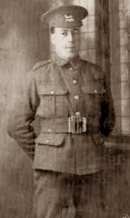 |
| George Arthur Ward was born in Loughborough in 1887, the oldest surviving child of George Joseph Ward, a coal waggoner, and his wife Ada (née Miller). George Arthur's parents were married in Loughborough either at the end of December 1883 or between January and March 1884. George Arthur had two younger sisters Alice and Ethel and a younger brother Frank; another sister Florence had died aged one. In 1891 the family lived at 6 Greenclose Lane, Loughborough, but by 1911 they had moved to 39 Granville Street, Loughborough. By 1911 George Arthur's father had become a gas stoker and George Arthur, aged 23, was a carter for a builder. George Arthur enlisted at Loughborough around mid-December 1914 and joined the Leicestershire Regiment as Private No. 16417. After an initial training period he was sent to France on 3rd May 1915 to join the 1st Battalion of the Leicesters. At the time the 1st Leicesters were part of the 16th Infantry Brigade of the 6th Division of the Army and were stationed near Armentières, resting after the continual fighting in critical days of autumn 1914. The 6th Division of the Army continued to hold a quiet but very extended front till the end of May, receiving a succession of units from new Divisions to serve their apprenticeship to trench warfare. On the 27th May 1915 began the relief of the Division by the 27th Division, and on the following days it moved northwards to join the newly formed VI Corps. On the night of the 31st May/1st June the Division took over its new front in the Ypres Salient, commencing its long tour in that difficult region, and trench casualties almost doubled immediately. George Arthur Ward was killed in action on 29th June 1915, aged 27. He appears to have been a victim of trench warfare, like so many others of his generation. George is commemorated on the Ypres Menin Gate Memorial, Panel 33. |
|
|
Private 27885 Herbert William (Bert) Ward |
|
|
9th Bn, Leicestershire Regiment. Killed in Action 2nd March 1917, Aged 27. Buried Vermelles British Cemetery, V. B. 42.
|
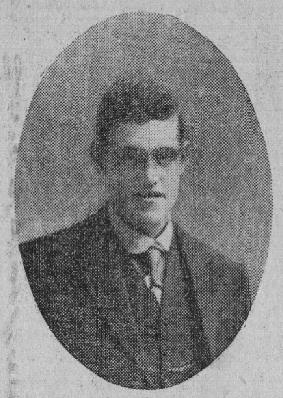 |
|
Herbert William Ward, known as 'Bert', was born in 1889 in Loughborough, the son of Ernest Cartwright Ward and Amelia Ward (née Barnett) who were married in 1888 in Cossington. Bert had a younger brother Alfred and a younger sister Clara. Bert's father was a hosiery machine builder and the Ward family lived in Loughborough - at 100 Freehold Street in 1891, 22 Station Street in 1901, and 44 Church Gate in 1911. Bert's mother died, aged 45, in 1911 and two years later Bert, who had trained as a joiner and carpenter with Messrs. William Corah and Sons, builders and contractors, married Mabel Florence Smith in Loughborough. Bert and Mabel set up home at 4 Baxter Gate, Loughborough, and their daughter Irene was born in late 1914.
Bert enlisted between March and April 1916 and joined the 9th Battalion of the Leicestershire Regiment as Private 27885. As his service record has not survived it is not known when he was sent to France, but it was possibly sometime in the summer or autumn of 1916. On 1st July 1916 the 9th Leicesters were ordered to move into position at Souastre in readiness to reinforce the troops attacking at Gommecourt. No orders came, however, and the men marched back to Humbercamps. Training continued on the 4th and 5th July. On 6th and 7th July they marched via Talmas to Crouy and on 8th and 9th July they rested and were addressed by the Divisional Commander on the forthcoming battle. On 10th July they moved to Ailly-sur-Somme and then entrained for Méricourt before going by bus to bivouacs in Méaulte north-east of Amiens. They then took over as Quadrangle Trench and Quadrangle support. On 11th there was heavy shelling but no infantry attack. On 12th July the 9th battalion was relieved and moved back to Fricourt. On 14th July the battalion moved up to the south edge of Mametz Wood just as an intense bombardment of the German positions began, and on to Bazentin-Le-Petit Wood. Finally relieved on 16th July the battalion, which had suffered heavy casualties, marched to Fricourt and on to Ribemont on the following day. On 18th July they entrained at Méricourt for Saleux. After nine days of marching and some motor lorry transit the battalion arrived at Arras on 27th July, where for all of August the battalion was in the trenches or resting in billets at Arras. After some days training and resting at the beginning of September the battalion marched to Frevent and entrained for 'Edgehill' station near Dernancourt. On 16th September the battalion moved to bivouac near Fricourt and after two days moved again to bivouac in front of Bernafay Wood. On 24th September the battalion moved up to the assembly trenches in front of Gueudecourt in preparation for an attack on the following day and were heavily shelled in the process. On 7th October they entrained at Pont Remy for Béthune and marched to Fouquières-lès-Béthune. On 10th October they marched to Sailly-la-Bourse and went into the support trenches in the Hohenzollern Sector where trench mortars from the enemy did considerable damage. Between 11th October and 15th December the battalion was either in the front line trenches, in the support line or in reserve. On 15th December the battalion was ordered to move to the Montmorency Barracks in Béthune where they stayed until 20th December when they marched to billets in Raimbart. The battalion remained in Raimbart in training until 27th January 1917. On 28th January the battalion marched to Lillers and entrained for Proven, from where they marched to billets in Houdeque-Watou. Training ensued until 13th February when they returned by train to Béthune. On 15th February they were back in the trenches in the Hohenzollern Sector and subjected to heavy enemy artillery fire. On March 2nd, during an enemy bombardment Bert was killed, aged 27. He was buried in Vermelles British Cemetery, Grave V. B. 42. |
|
|
Private 16488 Walter Bernard Waring |
|
2nd Bn, Leicestershire Regiment. Died of Wounds Mesopotamia 11th March 1917, Aged 19. Commemorated Basra Memorial panel 12.
|
|
Walter Bernard Waring, known as 'Bernard', was born in Loughborough in 1898. He was the son of Joseph James Ezekiel Waring (known as 'James Waring') and Catherine Waring (née Hull) who were married on 17th July 1897 at St. Paul's Church, Woodhouse Eaves. Bernard's father had attested for the Leicestershire Regiment 17th Foot on 6th September 1888 and before he was married had served in Bermuda, Halifax Nova Scotia and South Africa. Between February 1900 and August 1901 he was stationed in Egypt but his wife and young son remained in England at The Nook, Barrow on Soar. Bernard's father left the army in 1901 and the family moved to Sileby Road in Barrow. By 1911 the Waring family had moved to 9 Park Avenue Melton Mowbray as Bernard's father had taken a job as a slag cracker at a blast furnace. Bernard's parents later moved to 5 Peel Street, Loughborough, where they lived for the rest of their lives.
Bernard seems to have enlisted in the early part of 1915 but as his service record has been lost his exact date of enlistment is unknown. He joined the Leicestershire Regiment as Private 16488. After preliminary training he was sent to France to join the 2nd Battalion of the Leicesters on 4th October 1915. He joined his battalion in the field on 7th October. The 2nd Leicesters had just been fighting at the Battle of Loos with the Indian Corps, where they had been decimated and were now in urgent need of reinforcements. In November Bernard's battalion was ordered to the Persian Gulf where Britain was fighting Turkish forces allied to the Germans. On 5th December 1915 Bernard embarked at Marseilles and arrived at Basra on 31st December 1915. From there he travelled by boat up the River Tigris to Ali Gharbi, 150 miles south-east of Baghdad where his battalion joined the Tigris Corps under General Aylmer. In January 1916 General Townshend and his troops had been besieged at Kut-al-Amara since mid-December and three unsuccessful attempts were made to break the siege. Battles took place at Sheikh Sa'ad, the Wadi and Hanna resulting in many casualties. A further attack at Dujaila Redoubt in March failed, during which Bernard was wounded. He recovered and rejoined his battalion. In April 1916 No. 30 Squadron of the Royal Flying Corps carried out the first air supply operation in history. Food and ammunition were dropped to the defenders of Kut, but unfortunately their parcels often fell into the Tigris or into the Turkish trenches. On 5th April a battle began for Fallahiyeh which the British soon captured but with heavy losses. Beit Asia was taken on 17th April. A final effort against Sannaiyat was made on 22nd April but this was unsuccessful and the Allies suffered about 1,200 casualties in the process. During the remainder of April other attempts were made to dislodge the enemy from their position at Sannaiyat but without any success. All attempts to relieve Kut failed and on 29th April 1916 General Townshend was forced to surrender to the Ottomans at Kut. The surrender at Kut was a severe blow to British prestige and morale and the troops were exhausted by their efforts. The Tigris Corps nevertheless still maintained a close watch on the Turks in the areas of Sannaiyat and Beit Isa. In mid-May it became apparent that the enemy had withdrawn from Es Sinn and the British were able to occupy the Dujaila Redoubt. The intense heat in June, however, caused a heavy toll from sickness and disease among the troops. As the heat lessened in September and October 1916 the enemy had raised its activities in sniping and bombing from the right bank of the Tigris. In December the Tigris Corps had begun a long offensive operation with the purpose of dislodging the enemy from the right bank position and severing the enemy's communication channels. By 18th December the Tigris Corps had extended their grip on the Turkish defences and had cut in opposite Kut between the outer Turkish defences and the west of the Hai, while simultaneously bombarding Sannaiyat. By the end of February 1917 Kut had been reoccupied by the Tigris Corps and the final push towards Baghdad began. On 4th March Bernard's battalion marched to Shargy and on the following day to Azizieh. Bawi was reached on the morning of the 8th March and the battalion was ordered to proceed towards Baghdad on the night of the 8th March. A halt was made at 6.00am on 9th at the Shawa ruins and one hour later the enemy began to shell the advancing troops. Bernard was wounded at some point during this operation. He died of his wounds on 11th March 1917, aged 19. Bernard is commemorated on the Basra Memorial, Iraq, Panel 12. He was remembered at a memorial service for the fallen at Holy Trinity Church, Barrow on Soar, on 31st October 1917. Bernard's father, who reenlisted when war broke out, survived the war. |
|
Private 17203 Arthur Watts |
|
9th Bn, Leicestershire Regiment. Killed in Action 14th July 1916, Aged 34. Commemorated Thiepval Memorial, 2c & 3a.
|
|
Arthur Watts was born in Loughborough in 1882, the son of Edward Watts and Mary Ann Watts (née Pervin) who were married in Loughborough in 1866. Arthur's father was a carpenter and wheelwright and his mother was a hosiery worker. Arthur had four brothers Albert, Thomas, George, and Ernest and two sisters Harriet and Julia. Three other siblings had died before reaching adulthood. In 1881 the family lived at 53 Ashby Road, Loughborough, in 1891 at 81 Ashby Road, and in 1901 at 42 Union Street, Loughborough. Arthur's mother died in 1910 and in 1911 Arthur's father was living at 4 Regent Street, Loughborough, with his son Albert (also widowed), George and Ernest and three grandchildren. Arthur, meanwhile, now a hosiery hand machinist, was living at the Coach and Horses Inn in Kibworth Beauchamp, Leicestershire. Arthur enlisted just after the outbreak of war and joined the 9th Battalion of the Leicestershire Regiment as Private 17203. The 9th (Service) Battalion was raised at Leicester in September 1914 as part of Kitchener's Third New Army and joined 23rd Division as Divisional Troops. The units of the Division began to assemble at Bullswater and Frensham in Hampshire from September 1914 and the King, Queen and Princess Mary visited the fledgling Division on 29 September. In early December, as the weather worsened, the Division moved into Aldershot and then, at the end of February 1915, to Shorncliffe in Kent. In April 1915 Arthur's' battalion became part of the newly established 37th Division of Kitchener's 2nd New Army and the Division began to concentrate on Salisbury Plain. Arthur was encamped on Perham Down. On 18th August 1915 Arthur was sent to France and joined the 37th Division which was concentrating near Tilques. The 9th Battalion then moved via Watten, Houlie, St. Omer, Eecke and Dranoutre to Wulverghem and Bienvillers-au-Bois, a short distance from the front line. In the months that followed the 9th Battalion did tours in the trenches, alternating with the 7th Leicesters who relieved them. They were Involved in operations in Bailleul, Le Bizet, Armentières, Mondicourt, Beauval and Berles-au-Bois. In April 1916 the 9th Leicesters moved to the Doullens area for six weeks for cleaning up, resting and training. In mid-May they returned once more to the trenches in the Bienvillers-Bailleulmont sector. In June there was a series of nightly excursions into No-Man's Land with patrols attempting to gather information on the enemy's dispositions. On other occasions there were working parties out repairing the British barbed wire entanglements. The situation became increasingly hazardous as the month wore on when the Germans began to use a new and more accurate type of trench mortar. On 1st July 1916 the 9th Leicesters moved into position at Souastre in readiness to reinforce the troops attacking at Gommecourt. No orders came, however, and the men marched back to Humbercamps. Training continued on the 4th and 5th July. On 6th and 7th July they marched via Talmas to Crouy and on 8th and 9th July they rested and were addressed by the Divisional Commander on the forthcoming battle. On 10th July they moved to Ailly-sur-Somme and then entrained for Méricourt before going by bus to bivouacs in Méaulte north-east of Amiens. They then took over as Quadrangle Trench and Quadrangle support. On 11th there was heavy shelling but no infantry attack. On 12th July the 9th battalion was relieved and moved back to Fricourt. On 14th July the battalion moved up to the south edge of Mametz Wood just as an intense bombardment of the German positions began, and on to Bazentin-Le-Petit Wood. There were heavy casualties on this day and Arthur, aged 34, was one of those killed in action. Arthur is commemorated on the Thiepval Memorial 2C and 3A and on the memorial in the former St. Peter's Church, Loughborough. Arthur's brother Ernest also enlisted in 1914 but was discharged within a month as being unfit for service. |
|
Corporal 13410 William (Billie) Wesley |
|
(Nottingham) Royal Army Pay Corps. formerly 37905 Prince of Wales's (North Staffordshire) Regiment. Died of Pneumonia 9th July 1918, Aged 34. Buried Loughborough Cemetery 42/107.
|
|
William Wesley, known to his family and friends as 'Billie', was born in Loughborough in the spring of 1884. He was the youngest son of William Wesley and his wife Louisa Charlotte (née Levers) who were married in Loughborough in 1873. Billie's father was a greengrocer and fruiterer, with a business at 44 Baxter Gate, Loughborough. Billie had two brothers Alfred and George and four sisters Clara, Annie, Louisa and Hilda.
By 1901 Billie, aged seventeen, was a solicitor's clerk. In 1904 Billie's father and older brother Alfred were fined at Loughborough Petty Sessions for poaching rabbits at Nanpantan. His father's greengrocery business then went bankrupt in 1908, but appears to have been restarted in different premises by Billie's mother and sister Annie while Billie's father became a market gardener. By 1911 Billie's family had moved to 1 Shakespeare Street. Billie had now left home. He was working as a house, estate and enquiry agent and boarding with the Allett family at Cotes. On 25th September 1912 Billie, now described as an accountant, married Gertrude Muriel Brooks, a draper's daughter, at Christ Church, Mountsorrel, Leicestershire. Billie's father died in that same year, not long after the wedding. Billie and his wife went to live at Waterloo House, Mountsorrel, and by the summer of 1916 had two children Nora and Eric. Billie's service papers have not survived but he seems to have enlisted sometime in the summer of 1916. He was sent to join the Prince of Wales's (North Staffordshire) Regiment as Private 37905. Billie's experience in accounting, however, was clearly expertise that the Army greatly needed elsewhere and in 1916 or 1917 he was transferred to the Office of the Army Pay Corps (APC) at Nottingham. He was soon promoted to the rank of Corporal. The Offices of the Army Pay Corps performed a very important service for all soldiers serving their country in the Great War, a role which has been little studied. They ensured that each soldier received his pay on time and knew that his family was provided for through a series of family allowances. There were 28 Army Pay Offices in the UK and each APO was responsible for a number of corps and regiments in the British Army. Their workload increased dramatically as the war progressed and the offices were compelled to employ large numbers of unskilled women. By 1917 Pay Offices maintained nearly 10 million accounts, of which four million were for soldiers, two and a half million for wives and dependants and over three million for children. The Separation Allowance paid to soldiers' wives and dependants was changed seven times during the war, involving the issue of arrears to over two million dependants on each occasion. Each Pay Office also had to deal with a mountain of documentation and correspondence every day. Some of the correspondence was from soldiers' wives who did not know their husbands' exact location or regimental number, and some of the correspondence was only semi-literate. To add to the confusion, it sometimes happened that two or three men with the same name and initial enlisted on the same day, at the same place. These soldiers often had to be written to for the names and addresses of their dependants, and sometimes added complications arose if the men had been killed or died in the meantime. Billie died at the Albert Hall Military Hospital, Nottingham, on 9th July 1918. He was aged 34. He was said to have died of pneumonia, but it is highly possible that he was a victim of the first wave of 'Spanish' influenza pandemic which reached Nottingham in July 1918. The influenza pandemic of 1918-1919 killed more people than the Great War, known at somewhere between 20 and 40 million people. It has been cited as the most devastating epidemic in recorded world history. More people died of influenza in a single year than in four-years of the Black Death bubonic plague from 1347 to 1351. Known as "Spanish Flu" or "La Grippe" the influenza of 1918-1919 was a global disaster. Much of the high death rate can be attributed to crowding in military camps and urban environments, as well as poor nutrition and sanitation, which suffered during wartime. It is now thought that many of the deaths were due to the development of bacterial pneumonias in lungs weakened by influenza. The flu was most deadly for people ages 20 to 40, a pattern of morbidity unusual for influenza which is usually a killer of the elderly and young children. Billie was buried in Loughborough Cemetery, Grave 42/107. He is remembered on the memorial at Baxter Gate Baptist Church, Loughborough, and on the Carillon. |
|
Private 11706 Frederick West |
|
7th Bn, Leicestershire Regiment. Killed in Action 1st October 1917, Aged 22. Buried Buttes New British Cemetery XXVI. B. 10.
|
|
Frederick West, known as 'Fred', was born in Loughborough in 1895 and baptised on 5th January 1897 at All Saints Church, Loughborough. He was the son of Frederick West, a labourer, and his second wife Harriett Asher West (née Wignell) who were married at All Saints Church on 5th August 1895. Fred's father was a labourer who progressed to being a fettler and then an iron moulder for an engineering firm. In 1897 the West family lived at 14 Shakespeare Street, Loughborough. By 1901 they had moved to 58 Russell Street and by 1911 to 112 Russell Street. Fred had two brothers Edward and George and one sister Emma. Another brother Albert had died aged 2. In 1911 Fred, aged 15, was an iron turner at the Empress Works of Herbert Morris Ltd, crane manufacturers. Fred's parents later moved to 93 Russell Street. Fred enlisted in August 1914 and joined the 7th (Service) Battalion of the Leicestershire Regiment as Private 11706. From the depot at Glen Parva Fred was sent to the Salamanca Barracks at Aldershot for training. After being sent to the Andover area in March 1915 the battalion moved to Salisbury Plain in April where on 25th June they were inspected by King George V at Sidbury Hill. On 29th July 1915 they received orders to proceed to France. The 7th Leicesters set sail for France on the SS Onward 'in utter darkness and complete silence'. There was no-one to see off the 110th Brigade as ships leaving full of 'Tommies bound for France' was no longer exciting. In September the 7th Battalion was sent to the area of Berles-au-Bois, south-west of Arras. The battalion remained in this area around Bienvillers and Bailleulmont until April 1916 and was engaged in localised operations seeking a tactical advantage. When not in the trenches being subjected to enemy shelling the 7th Leicesters received intensive training in bombing, Lewis gunnery, visual signalling and a host of other activities. In April 1916 they were moved to the Doullens area and formed working parties to cut down trees and prepare brushwood for the front line as well as preparing the support trenches in the area. In May they worked on building a new railway line between Le Bret and Bienvillers-au-Bois. Towards the end of May the battalion returned to the trenches in the Bienvillers-Bailleulmont area. At the beginning of July the 7th Battalion moved on to the Somme. They were at Fricourt on 13th July and at Mametz Wood and in the attack on Bazentin-le-Petit on 14th July. After the Bazentin Ridge battle the battalion marched away from the Somme and entrained for part of the journey to Hangest. On 6th August they took over a section of battered trenches at Agnez-lès-Duisans, near Arras. After ten days training at Denier and Sars-le-Bois the battalion entrained again for the Somme on 12th September and bivouacked outside Montauban north-east of Bernafay Wood. On 25th September they fought very bravely and successfully at Gueudecourt in an action which was part of the Battle of Morval. On 4th October the battalion entrained once more for the north and the countryside of Loos, taking over positions opposite the Hohenzollern Redoubt with rest billets at Mazingarbe, Philosophe, or Vermelles. Training at Cauchy-à-la-Tour and Houtkerque followed until 12th February 1917. On 13th February the battalion entrained at Proven for Fouquerieul and marched to billets in the tobacco factory in Béthune. Moving on to Labourse they were back in the trenches in the Hohenzollern sector on 15th February, moving up to the front line on 21st February. Breaks from the trenches were taken in Noyelles. In March 1917 the battalion experienced what one soldier called 'the bombardment of our lives'. On 29th March the battalion entrained at Noyelles for Saulty-L'Arbret and marched to La Cauchie and on to Moyenville. On 4th April the battalion went into the front line at St. Leger Croisilles, with breaks at Moyenville. From 15th to 23rd April the battalion was in training at Bailleulval before returning to the trenches at St. Leger Croisilles. On 28th April the battalion was in action at the Battle of Arleux and on 3rd May in reserve for the 2nd Battle of Bullecourt, moving into the front line on 4th May. From 4th -11th May the battalion suffered from very heavy enemy shelling. From 12th-31st May the battalion was withdrawn for training at Bienvillers. Further training and trench tours followed in the Moyenville area in June, July and August, followed by a break in Hamelincourt. On 25th and 26th August the battalion marched to Gouy-en-Artois and then Beaufort for training. After a further move to Hauteville for more training and a football tournament and boxing competition, both of which the 7th Leicesters won, on 16th September the battalion entrained at Savy station for Caestre. Fred, however, was now on two weeks leave. On 23rd September the battalion marched to Berthen. On 26th September they moved by bus to Scottish Wood and then to Bedford House as reserve in the forward area. After two days rest at Micmac Camp, where Fred rejoined them, the battalion was back in the forward area on 29th. The 3rd Battle of Ypres had been raging for two months and the ground was full of water-logged shell holes, which had to be negotiated over duckboards. The 7th Leicesters joined the battle on the night of the 30th September, marching up to Polygon Wood, which had been captured by the Australians. The 9th Leicesters took over positions in the right half of the Polygon sector just outside the wood with the 7th Battalion behind them in support and the 6th Leicesters in reserve. On 1st October the enemy began a heavy barrage. The Leicesters nevertheless pushed forward. Fred West, aged 22, was one of 26 Ordinary Ranks killed in action that day. He was buried in Butts New British Cemetery, next to Polygon Wood, Grave XX1V. B. 10. His mother paid to have the words 'Rest in Peace' engraved on his headstone. In a letter to Fred's parents a chum in the company said that Fred was shot through the head by a German sniper and died instantly. He added that 'his closest chums found his death a great loss for he was always one of the best'. |
|
Private 20909 Frederick West |
|
|
2nd Bn, Leicestershire Regiment. Killed in Action 9th April 1916, Aged 29.
Commemorated Basra Memorial panel 12.
|
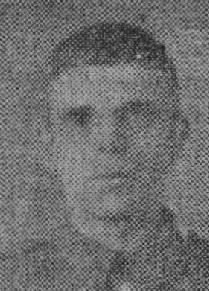 |
|
Frederick West was born in Loughborough in 1886, the son of James Cooke West and his wife Clara (née Whelband). His parents were married in Loughborough in 1874 and James Cooke West was a house painter. Frederick had four brothers George, James, Charles and Albert and three sisters Martha, Rebecca and Clara, two other siblings having died in infancy. In the 1880s and 1890s the family lived at 71 Wellington Street, Loughborough, but later moved to 47 Moor Lane. In 1901 Frederick, aged 15, was a hosiery circular stitcher but he later became a weaver in a plastic web factory. On 9th March 1912 Frederick married Nellie Ada Green who was also an elastic weaver in Loughborough. Frederick and Nellie settled at 3 Conery Passage and had two children: Winifred (born 1913) and Frederick (born early 1916). Frederick enlisted at Loughborough on 19th August 1915. He joined the Leicestershire Regiment as Private 20909. From the Depot he was sent to Barnard Castle, County Durham, on 4th September where he remained until 2nd November 1915 when he was posted to Rugeley Camp in Staffordshire. On 17th February 1916 he was once again posted, this time to join the 2nd Leicesters in the Persian Gulf. Frederick arrived in Basra from Devonport on 21st March and travelled up the Tigris to join his battalion on 3rd April. His battalion was in the area of Hanna and the Dujaila Redoubt and still making attempts to relieve the Siege of Kut. On 5th and 6th April heavy bombardment on the enemy's position on both banks of the Tigris was carried out and the enemy retired to Fallahiya and then Sannaiyat. In the mistaken belief that the enemy had subsequently abandoned Sannaiyat troops including the 2nd Leicesters were ordered to advance into the area. They unfortunately found themselves under heavy enemy fire and during this action on 9th April 1916 Frederick was killed, aged 29. He is commemorated on the Basra Memorial panel 12 and on the Carillon. |
|
|
Able Seaman (Bristol) Z/9085 Walter Charles Whatnall |
|
Died at home 8th November 1920, Aged 43. Buried Birmingham Lodge Hill Cemetery and commemorated on Screen Wall B10. 8.590. |
|
Walter Charles Whatnall was born in Loughborough on 30th December 1876. He was the son of Henry Whatnall and his wife Charlotte (née Preston) who were married in Loughborough on Christmas Eve 1870. Walter's father was a carpenter and joiner who in later life became a cabinet maker for a home furnishing company. Walter had two brothers George and Albert and two sisters Agnes and Ada. In 1881 the Whatnall family lived at 17 Factory Street, Loughborough. They later moved to 85 Derby Road. In 1901 Walter's parents were at 12 Wharncliffe Road and then moved to No. 34 in the same road.
In 1891 Walter, aged 14, was an errand boy for a shoe dealers. In late 1897 or early 1898 Walter, now a joiner like his father, married Jane Goodacre Warner in Loughborough. Jane Warner already had one son, born in 1896, and registered as Walter Whatnall Warner. In 1901 Walter and Jane were living at 24B Moira Street with three young children Walter Whatnall Warner (now known as Walter Whatnall), Mabel and Grace. Another child Frank had died shortly after birth in 1899. By 1911 Walter (Senior) and Jane had moved to 41 Edward Road, Clarendon Park, Leicester, and Walter had become a carpet fitter. Between 1911 and 1914 the family moved to 3 Alfred Terrace, Great Colmore Street, Birmingham, where another son Francis Whatnall was born in 1914. Walter enlisted with the Royal Naval Volunteer Reserve on 15th December 1915. He was summoned to the Recruiting Depot on 15th June 1916 and taken on strength of the 4th Reserve Battalion at Blandford, Dorset, as Ordinary Seaman Z/9085 (Bristol). On 1st October he was rated an Able Seaman and on 8th October was transferred to the 3rd Reserve Battalion. On 21st November he was drafted for the British Expeditionary Force and entrained at Blandford. On 4th January 1917 Walter joined the 7th (Hood) Battalion which was in the area of the River Ancre in Artois, surviving the rain, snow, fog, mud fields, waterlogged trenches and shell-holes. On 18th January, however, Walter was sent to hospital with influenza and on 27th January he was admitted to the 7th Canadian General Hospital at Etaples. On 15th February he was sent to the 6th Convalescent Depot at Etaples and on 19th March to the 5th Convalescent Depot at Cayeux-sur-Mer on the Channel coast. On 7th April Walter was discharged to the Base Depot. In May he was assessed by a Medical Board in Calais and discharged to the UK on account of his age and general debility. Walter returned to Blandford and was transferred to administrative duties on HMS Victory 1, an accounting shore base at Portsmouth, until 1st August 1918. On 2nd August he was posted to HMS Lavatera, a hired Banff drifter at Inverness and nominal parent ship for boats of the Auxiliary Patrol. Walter was demobbed on 24th February 1919. Walter returned home to Birmingham where he died, aged 43, on 8th November 1920. He was buried in Birmingham Lodge Hill Cemetery, and is commemorated on Screen Wall B10. 8.590. On 30th September 1922 Walter's widow Jane emigrated with her youngest son Francis on SS Orvieto (Orient Lines) to Melbourne, Australia, to join her eldest son Walter. She died in Carlton, Melbourne, in 1947. |
|
Private 241240 Arthur Whitbread |
|
1/5th Bn, Leicestershire Regiment. Killed in Action 28th/29th July 1917, Aged 26. Buried Philosophe British Cemetery I. T. 53.
|
|
Arthur Whitbread (or Whitebread) was born in 1892 in Loughborough, the youngest son of Edward Whitbread (or Whitebread) and his wife Elizabeth Frances Thornton. Arthur's parents were married on 18th April 1881 at All Saints Church, Loughborough and his father was a wicker basket maker. Arthur had three brothers Herbert, Edward and Ernest. In 1901 the Whitbread family lived at 15 Canal Bank, Bridge Street, Loughborough, and by 1911 had moved to 49 Granville Street. In 1911 Arthur, aged 19, was a porter. Arthur's oldest brother Herbert served with the Leicestershire Regiment for eight years and died from peritonitis in 1908 while with the Regiment in Bellary, India. Arthur joined the 1/5th Leicestershire Regiment as Private 3533 (later renumbered as Private 241240). The date of his enlistment, however, is unknown as his service record has not survived. He was sent to France on 26th June 1915, when the battalion was on the Ypres Salient near Zillebeke. The battalion remained here until the beginning of October when they were ordered to move towards Loos. On 12th October 1915 the battalion travelled to the Hohenzollern Redoubt. They spent the next eight hours in communication trenches. On 13th October 1915 during the attack on the Redoubt, part of the final stages of the Battle of Loos, the 1/5th Battalion was in reserve until just after midday, when they 'went over the top' and came under intense machine gun fire. In late October the battalion rested at Drouvin before moving to Calonne-sur-la-Lys for two trench tours between Neuve Chapelle and Festubert . They then moved on to billets at Merville for training. Training continued at Thiennes from 19th December until Boxing Day when the battalion moved into billets at Aire. In early January 1916 the battalion was sent to Marseilles to await transport to Egypt. They had only just embarked on H.M.T. Andania when orders came that they were to disembark and travel back to the Somme area of Picardy - Gallipoli had been successfully evacuated and they were no longer needed in Egypt. In mid-February orders came for the battalion to take over the line north of the River Ancre opposite Beaumont-Hamel. On 29th February the battalion moved to the area of Doullens where the men worked on improving the trenches despite being subjected to a considerable bombardment from the enemy with mines and craters being blown. From 9th March 1916 the 1/5th Leicesters were in the area of Vimy Ridge, Pas de Calais, either in the front line, in support, in reserve or at rest. On 27th April the battalion was sent to the neighbourhood of Neuville St. Vaast to work with the French and English tunnellers and then to billets in Luchaux for bayonet training. This was followed by a period at Souastre digging cable trenches, and constructing bomb stores and gun pits in preparation for a 'big push'. On 4th June 1916 the battalion was moved up to trenches near Gommecourt. This was followed by further training at Warlincourt. On 30th June the battalion assembled in a trench near Foncquevillers Church ready for the diversionary attack at Gommecourt on the first day of the Somme Offensive planned for 1st July. On 1st July 1916 the 46th Division of the Army, of which the 1/5th Leicesters were part, had 2445 casualties at Gommecourt. Arthur survived this battle and on 3rd July went with his battalion into billets at Bienvillers. On 7th July they relieved the 4th Lincolnshires in the trenches opposite Essarts-lès-Bucquoy. The battalion remained in the area of Monchy-au-Bois until 29th October, either in the trenches or resting at Bienvillers or Pommier. The battalion's next move was to Millencourt for intensive battle training, returning to Halloy and then Souastre at the beginning of December. The battalion remained at Souastre until 11th March 1917 and then moved once more up to the line taking over 2,600 yards of frontage from the La Brayelle road to the Hannescamps-Monchy road. On 17th March they moved into Gommecourt for road mending before moving to Bertrancourt, Raincheval and then Rainvillers not far from Amiens. On 28th March the battalion marched to Saleux, entrained for Lillers in the north, and marched to Laires. Training took place until 13th April and continued for three further days at Manqueville, after which the battalion moved to the western outskirts of Lens. From there they marched to Bully-Grenay and went into the front line trenches where they were heavily shelled. On 29th April the battalion went into rest billets in cellars at Cité St. Pierre until 3rd May when they went into support trenches. On 8th they went into billets at Fosse 10 near Petit Sains for training and on 12th into reserve at Angres. Further trench tours south-west of Lens followed until 26th May when the battalion went into billets at Marqueffles Farm for training in bayonet fighting and bombardment and to practise methods of attack. On 6th June the battalion was back in the line and on 8th June went into the attack, suffering 96 casualties. Apart from two breaks at Red Mill from 9th-13th and 18th-20th June the battalion was in the trenches until 22nd June. On 21st June C Coy was accidentally gassed by the Royal Engineers, resulting in 94 casualties of whom 22 died. Back at Marqueffles Farm from 22nd the battalion had Lewis gun and signalling classes as well as attack training over a flagged course. On 27th June the battalion moved up to the line ready to attack on the following day. As they climbed out of the trenches on 28th June they met with the inevitable machine gun fire. On 30th June the battalion was heavily shelled. On 1st July they took over a captured new line near Lievin and were again shelled. From 3rd-21st July the battalion was in training at Monchy. The next move was to Vaudricourt and the Hulluch trenches. On the night of 28th/29th July, as the battalion was being relieved from the trenches Arthur, aged 26, was killed. Arthur was buried in Philosophe British Cemetery, Grave I. T. 53. |
|
Lance Corporal 16011 Hubert Ronald White |
|
1/6th Bn, South Staffordshire Regiment. Died of gas poisoning and pneumonia East Suffolk and Ipswich Hospital 9th June 1918, Aged 25. Buried Loughborough Cemetery 20/283.
|
|
Hubert Ronald White was born on 14th March 1893 in Twycross, Leicestershire. He was the son of William Joseph White and his wife Sophia (née Butcher) who were married at St. James's Church, Piccadilly, London, on 6th October 1883. Hubert's father was originally a blacksmith in Twycross, but by 1901 he had become a gardener and groom, by 1911 a labourer in an iron works, and by 1917 a coal miner. Hubert had three brothers Frank, Arthur and Cecil (who was deaf and dumb from childhood) and two sisters Catherine and Lily. In 1901 the family lived at Alton Cottage, Ravenstone, Leicestershire, and in 1911 at 72 Albert Street, Coalville. Hubert began his education, aged three, on 25th March 1896 when he was admitted to Norton Juxta Twycross Church of England School. When he left school he was employed as a hewer's filler in a coal mine.
Hubert enlisted in Coalville soon after war broke out and joined the South Staffordshire Regiment as Private 16011. He was sent for training in Saffron Walden, Essex, and dispatched to France to join the 1/6th Battalion on 24th August 1915. He arrived in the Ypres Salient just as the battalion finished a trench tour at Hill 60 and moved to Canada Camp. In September the1/6th Battalion spent a week in Brigade reserve at Zillebeke, completed two more trench tours at Hill 60 and also provided digging parties for the Royal Engineers. On 2nd October the battalion marched to Abeele, entrained for Fouquereuil, and marched to Robecq for two days drill and training. Instruction continued at Vaudricourt and included practice in marching over open ground in fighting order. On 12th October the men went into the assembly trenches north-east of Vermelles and on 13th October were ordered to take part in the capture of the Hohenzollern Redoubt and Fosse 8. After the initial attack failed the battalion was withdrawn to Sailly Labourse and then Vaudricourt before being sent to Allouagne and Fouquereuil for further training. Training continued for the first two weeks of November at Lestrem and Croix Barbée, followed by four trench tours at Neuve Chapelle with breaks at Croix Barbée. From 5th-24th December the battalion was inspected and underwent drill and other training at Pacaut and Le Pont à Balque. On Christmas Day the battalion entrained at Berguette and travelled to Marseille where they transferred to Santi Camp. After spending a week on drill, inspections, learning rapid loading and bugle practice the battalion embarked on HMS Magnificent and sailed for Egypt on 2nd January 1916. The battalion reached Alexandria on 8th January, entrained for Shallufa and camped on the East Bank of the Suez Canal. After constructing a fort in the desert north-east of Shallufa the battalion was ordered back to Sidi Bishr Camp, Alexandria. Six days later they embarked on the HT Transylvania for Marseille, arriving on 10th February. They then entrained at Arenc station for Longpré and marched to Vauchelles. Training took place at Vauchelles, Baumetz and Atheux until 5th March. After this the battalion moved to Mont St. Eloi and began a series of trench tours at Neuville St. Vaast with breaks at Ecoivres. Between 21st April and 4th May the battalion was in training at Monchy Breton and returned to the trenches at Fonquevillers on 12th May. Here they suffered from several heavy enemy bombardments. The remainder of May and the first half of June were spent at Sus St. Leger practising for an attack and providing working parties at Lucheux Forest and Humbercamps. Two more trench tours and working parties at Fonquevillers occupied the rest of June. On 1st July 1916, the first day of the Somme Offensive, the battalion was ordered to take part in the attack on Gommecourt. Only one company managed to penetrate the enemy's front line and the battalion had 239 casualties from its fighting force of 523. The remainder of the battalion was withdrawn to St. Amand and then to Brigade reserve at Berles-au-Bois. For the rest of July until the end of October the battalion was on trench tours at Berles-au-Bois or was in Brigade or Divisional reserve at Bailleulmont. Throughout November and until 9th December the battalion was training at Yvrencheux, Agenvillers, Le Souich and Pommier, after which they returned to the trenches at Bienvillers-au-Bois. From mid-December 1916 until 5th March 1917 the battalion remained in the Bienvillers-au-Bois area, engaged on a series of trench tours with periods in Divisional or Brigade reserve at St. Amand, Pommier or Berles-au-Bois between tours. During the trench tours the battalion was shelled and bombarded a number of times by the enemy. On 11th March, after three days training at Pommera the battalion moved to Bayencourt and then to Biez Wood in reserve for an attack on Bucquoy. The next move was to Hannescamps for salvage work in the trenches and the clearing of road barricades. On 23rd March the battalion began a nine-day transfer by march, bus and train to Auchy-au-Bois for training until 17th April. On 18th April they went into the trenches at Liévin where they were heavily shelled and fired on by the enemy during an unsuccessful attack and suffered 40 casualties. After a rest at Sains-en-Gohelle and five days in Brigade reserve at Red Mill, Angres, the battalion returned to the trenches in early May to be on the receiving end of an enemy gas shell attack. From the 8th-18th May the battalion was in reserve at Sains-en-Gohelle for rifle and kit inspections, training and innoculations. Three more trench tours took up the remainder of the month during which the battalion supported a successful attack but incurred 38 casualties in 24 hours. June included two trench tours, two periods in Brigade reserve at the Cité St. Pierre and a week in Divisional reserve at Bouvigny-Boyeffles for rest and training. Towards the end of the month the battalion took part in an advance near Liévin, gaining ground up to the crest of Hill 65. Following two days in Divisional reserve at Bully-Grenay they were again in action in a successful attack on the enemy defences west of Lens on 30th June and 1st July. Casualties, however, for June and 1st July were high, numbering 221. On 2nd July the battalion travelled by bus from Les Brebis to Burbure where they rested and trained until 24th July. Training continued at Fouquières and Labourse until 3rd August. From 3rd August 1917 to 24th January 1918 the battalion was in action in the Hulluch sector, with periods in reserve at Noeux-les-Mines, Verquin, Mazingarbe and Noyelles. For nearly three weeks in September 1917 they were also attached to the 3rd Australian Tunnelling Company and the 466th Field Company of the Royal Engineers for pioneer work. While in reserve they undertook training, and enjoyed games of football as well as, on one occasion, a concert party by the Whizzbangs. Christmas Day 1917 was spent in the trenches and the Germans were heard calling across 'A Happy Christmas, Staffs'. Hubert, however, was not with the battalion at this point as he had been granted a short period of leave. On 22nd December 1917 he was married by Licence to Ethel Miller, daughter of Henry Miller Secretary of the Borough Band, at Emmanuel Church, Loughborough. Hubert returned to France, leaving his wife with her parents at 54 Ashby Road, Loughborough. From 24th January until the end of February 1918 Hubert's battalion was based at Vaudricourt and Fontaine-les-Boulans for training. Between 1st and 6th March they moved via Auchy-au-Bois, La Miquellerie and Beuvry to Annequin and Le Preol for two trench tours in the Cuinchy sector. On 27th March they transferred by bus and march to Columbia Camp, Souchez, before entering the trenches in the Lens sector. After a heavy gas bombardment by the enemy on 8th April the battalion was moved to Divion for rest, training, and sports. They also enjoyed two concert parties, one by the First Army and another by the Canadian Depot Machine Gun Corps Troupe. On 17th April the battalion pitched camp by the railway embankment at Hallicourt and continued training. On 24th April the battalion marched to Fouquières where, on the following day, they went into the front line and took part in some hard fighting over the Route A Keep. On 1st May the enemy opened a gas shell bombardment for four hours resulting in heavy casualties among the men. Hubert was one of those gassed. He was brought back to England and taken to Barlett Ward of the East Suffolk and Ipswich Hospital. He died there, aged 25 and a Lance Corporal, from gas poisoning and pneumonia on 9th June 1918. Hubert was buried in Loughborough Cemetery, Grave 20/283. A firing party from Glen Parva attended the ceremony and fired volleys over the grave, and The Last Post was sounded on the bugles. The bearers were all local men home on leave. Comrades of Hubert at Ipswich hospital sent a wreath. 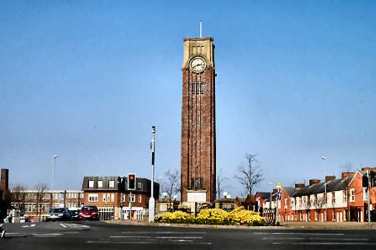 Clock Tower Memorial, Coalville Hubert is remembered on the Clock Tower Memorial, Coalville, and on the memorial in Christ Church, Coalville. Hubert's widow Ethel was remarried to Ernest Brewin on 26th June 1920 at Emmanuel Church, Loughborough. |
|
Private 50183 Ernest William Whitesmith |
|
|
17th Bn, Sherwood Foresters (Notts & Derby Regt.)
Killed in Action 15th September 1917, Aged about 29 or 30. Buried Perth (China Wall) Cemetery, Zillebeke, II. G. 4.
|
|
|
Ernest William Whitesmith was born in Loughborough in about 1887 (the exact year being uncertain as his birth was never officially registered). Ernest's parentage is also obscure but it seems that he may have been the natural son of Dinah Whitesmith by an unknown father.
In 1891 Ernest was living in the household of widowed Jane Whitesmith (probably his grandmother) and her children John, Dinah and Henry at 1 Court E, Baxtergate, Loughborough. By 1901 Dinah Whitesmith, a hosiery worker, was married to John Cresswell and living at 2 Cemetery Place, Loughborough. Ernest was listed on the 1901 census in the Cresswell household as 'Ernest Cresswell', the son of John and Dinah Cresswell. In 1908 Ernest, calling himself 'William Ernest Whitesmith' married Agnes Mary Hunter. According to the 1911 census Agnes Whitesmith was living at 52 King Street, Loughborough. With her were her daughter Doris and her sister-in-law Annie Whitesmith who was probably a sister or half-sister of Ernest. Ernest's whereabouts and occupation on the 1911 census night are unrecorded. Ernest and Agnes had four children Doris, William, Norman and Vera, but only Doris survived infancy. Ernest enlisted in the late summer of 1915, but his exact date of enlistment is unknown as his service papers have not survived. He joined the newly formed 17th (Service) Battalion (Welbeck Rangers) of the Sherwood Foresters (Notts & Derby Regiment) as Private 50183. In October 1915 the battalion moved to Aldershot under orders of the 117th Brigade in the Army's 39th Division and then in November 1915 to Witley Camp, Surrey. On 6th March 1916 the battalion entrained at Milford for Southampton Docks and embarked on three transports: the RMS Connaught, the SS Archangel and SS Inventor. Having disembarked at Le Havre on the following day the battalion encamped at Bleville. On 8th March they entrained at Le Havre for Steenbecque. On 13th and 14th March they marched via Estaires to Sailly and went into Divisional reserve in billets near Cul de Sac Farm. After five days of inspections the battalion marched to a new billeting area at Estaires. Two companies then went to the trenches for three days of instruction by the 2nd Battalion of the Middlesex Regiment. On 22nd March the other two companies went to the trenches for instruction by the 2nd Battalion of the Devonshire Regiment. From 28th March until 5th April the battalion was at Busnettes for further inspections before marching via Béthune to Annequin. On 7th April two companies of the battalion went to hold a trench on the Auchy line, supervised by the 20th Battalion of the Royal Fusiliers. The other two companies relieved them on the following day. From 10th-14th April the battalion was in the trenches in the Auchy right sub-sector and was heavily bombarded by the enemy. They then moved to billets in Béthune before going into Divisional reserve at Hingette two days later. On 23rd April they marched to Le Touret and went into the front line at Festubert until 1st May. During May the battalion worked on the front lines at Festubert, Gorre and Givenchy, with breaks at Festubert and Hingette. June began with training near Gorre and on 11th June the battalion began a trench tour at Festubert which lasted for an extraordinary thirty-four days, included the opening of the Somme Offensive, and caused 130 casualties. On 14th July the battalion moved into Brigade support at Richebourg St. Vaast and on 26th July into Brigade support in the Givenchy sector. A raid on the enemy's trenches on 1st August cost the battalion another 69 casualties. Much of the rest of August was spent in training at Essars and Orlencourt. Between 24th and 31st August the battalion moved by train and route march via Bouquemaison, Doullens, Vauchelles-les-Authie and Bertrancourt to Vitermont near Englebelmer and was then in position to take part in the 2nd Somme Offensive. On 2nd September the battalion went into the trenches near Beaumont-Hamel and on 3rd went into the attack until ordered to withdraw to the trenches and then to Mailly-Maillet Wood. The battalion suffered 454 casualties. The battalion was reinforced and returned to the trenches on 12th September. After a break at Beaussart a further trench tour in the Serre sector began on 20th September, followed by a break in Bertrancourt and Hedauville for inspections. The battalion returned to the trenches in the Thiepval sector on 4th October and were subjected to heavy enemy artillery shelling. On 8th October the enemy bombed the battalion's line but on the following day the battalion took part in a successful attack on the Schwaben Redoubt. Between 10th and 15th October the battalion was in huts in Martinsart Wood for training. They then returned to the Thiepval trenches for four days and suffered 62 casualties. During the remainder of October they completed two further trench tours in the area of Thiepval and the River Ancre and provided carrying parties to the front line from Authville before taking a break at Senlis. In early November the battalion completed two trench tours in the River Ancre sector and on 13th November took part in operations during which 700 prisoners were taken. After moving to Warloy and Gezincourt they entrained at Candas for St. Omer on 17th November and marched to Tentinghem. Between then and 21st December the battalion was attached to the 2nd Army Central School of Instruction for a programme of work. On 22nd December the battalion moved by train to Ypres and marched to the Canal Bank where they were in the trenches until 13th January 1917. Christmas Day 1916 was belatedly celebrated at C Camp, Voxvrie, Poperinghe, on 16th January 1917, followed by training and then a return to the trenches, this time at Kaaie, Ypres, on 25th January. Between 1st February and 11th April the battalion did seven trench tours in the Ypres area, with working parties in the front line, ten days training at Voxvrie and breaks at St. Lawrence and Montreal Camps. On 12th April they entrained at Poperinghe for Esquelbecq and marched to Bollezeele where training and attack practice took place until 27th April. The battalion then returned to Poperinghe to work on railway construction under the Royal Engineers until 14th May. On 15th May the battalion entrained at Brandhoek for Ypres and went into the trenches in the Hill Top sector. On 23rd May they moved into support on the Canal Bank before returning to Hill Top. From 8th-16th June the battalion was based at O Camp and provided working parties for the Royal Garrison Artillery as well as undergoing training. On returning to Hill Top and the Canal Bank trenches they suffered 61 casualties. At the end of June, while on night work from C Camp, there were 18 further casualties. On 1st July the battalion marched to Poperinghe, entrained for Watten and proceeded to Moulle. Here, until 20th July, the battalion underwent training and attack practice. Training continued at A30 Camps until 29th July when they moved to Hill Top and to the assembly position on the following day. From 1st-4th August the battalion was in the flooded trenches at the Steenbeek and was intensely shelled by the enemy. After being relieved the battalion eventually reached the Canal Bank before transferring by march, rail and bus to Le Roukloshille for cleaning up and training. In mid-August the battalion went into support in the Ravine Wood dugouts in the Klein Zillebeke sector. From here they carried material for the Royal Engineers and at night worked on wiring, all amid intense enemy fire. On 19th August the battalion moved to Bois Confluent in support and on 27th August into the trenches in the Hollebeke sector. Between 29th August and 12th September the battalion underwent training at Chippewa Camp and at the Bois de Beauvoorde. On 12th September they returned to the trenches in the Shrewsbury Forest sector. Ernest, aged about 29 or 30 years, was killed in action on 15th September 1917. He was buried in the Perth (China Wall) Cemetery, Zillebeke, Grave II. G. 4. |
|
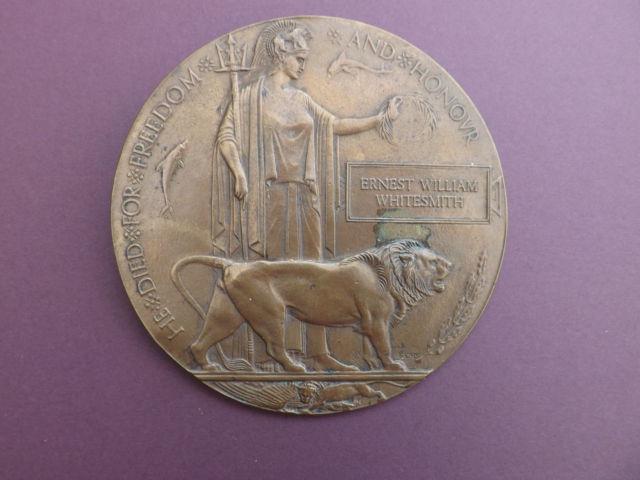 |
|
|
Sergeant 305161 Herbert Walker Widdowson |
|
2/8th Bn,Sherwood Foresters (Notts & Derby Regt.) Killed in Action 7th April 1917, Aged 29. Commemorated Thiepval Memorial, 10c, 10d & 11a.
|
|
Herbert Walker Widdowson was born in 1887 in Loughborough, the son of Walter and Emma Widdowson (née Walker) who were married in Loughborough in 1884. Herbert's father was a hosiery machine fitter and in 1891 the Widdowson family lived at 56 Paget Street, Loughborough. Herbert had one brother Arthur and one sister Eva. By 1901 the family had moved to Narrow Lane, Hathern, to live next door to Herbert's widowed grandmother Sarah Widdowson. Herbert's parents later moved to 20 Chestnut Street, Loughborough. Herbert became a joiner and wheelwright and in 1911 he was living and working with his uncle Wilfred Widdowson on the Thoresby Hall estate, Budby, near Ollerton, Nottinghamshire. Herbert married Maude Nixon in the early summer of 1914 at Budby but the couple were not together for long. Herbert was already in training with the Territorials when war broke out and was immediately called up. As Private 35161 he went with the 2/8th Battalion of the Sherwood Foresters (Nottinghamshire and Derbyshire Regiment) for special training at Newark. On 1st February 1915 the battalion moved to Luton and from there to Billericay until the end of the month when they returned to Stockwood Park, Luton for training in Japanese musketry. Another move followed to Dunstable before the battalion was sent to Watford at the end of August. In April 1916 Herbert's battalion was pulled out of Watford and sent to quell the Irish rebels of the Easter Uprising in Dublin. The men were only equipped with Lee-Enfield rifles and bayonets; they had no hand grenades. At Watford each battalion had been provided with two Lewis machine guns each capable of firing .303 calibre bullets at a rate of up to 600 rounds per minute. At Liverpool, however, a loading officer made the grave error of insisting they left the Lewis guns behind. The Rebels under the command of Éamon de Valera were, in contrast, well-trained, well-equipped and on home ground. The battalion was ordered to march through the centre of Dublin where it was caught in merciless crossfire in the area of Mount Street Canal Bridge and Northumberland Road and suffered numerous casualties. On the following day the 2/8th battalion was detailed to escort a consignment of ammunition to the Royal Hospital in Kilmainham, Dublin. Forcing their way through sniper fire they approached the South Dublin Union. As they came in sight rifle fire erupted from the Nurses' Home which, unknown to them, was held by members of the 4th Battalion of the Irish Volunteers. The Foresters attempted a frontal assault on the building but suffered casualties as they were repulsed by heavy fire and the battle for the Nurses' Home, both inside it and in the grounds, continued until the late evening. After the Irish Rebellion was quelled the battalion spent the rest of the year on garrison duty in Ireland before finally reaching France on 23rd February 1917 where it had its first taste of trench warfare at Le Verguier north-west of St. Quentin. Herbert was killed in an attack there on 7th April 1917, aged 29. He had been promoted to the rank of Sergeant before he died. The news was conveyed to his wife in a letter from his Captain which read as follows: 'I am very sorry indeed to have to write and tell you of the death in action of your husband, Sergt Widdowson. You will probably have heard before now, but you may care to have such details as I can give. He was in command of a platoon during recent operations, and his loss to the company will be great. As far as I can find out, his death was painless and he has been buried a little apart from others who fell at the same time, and a cross is being put over his grave. I am trying to get his bounty which was due to him, paid in to you. I can only end by repeating how great a loss he is to us and by offering my deepest sympathy of all who knew him - Yours sincerely, J S Oates, Capt.' The Chaplain wrote: 'I am very sorry to tell you that your husband, Sergt Widdowson, was killed in action in the early hours of last Saturday, Easter Even. May I assure you of my deep sympathy with you in your loss. At the same time, I know you will be very proud that he died so gallantly. He is exceedingly highly spoken of by both officers and men, and is greatly missed throughout the battalion. You may be certain that he was killed outright and suffered no pain. I buried him on Tuesday last with some of his comrades and a cross is being erected on his grave. May God bless and comfort you and grant him rest - Yours very truly, Stanley Hide, Chaplain, C of E.' Herbert is commemorated on the Thiepval Memorial, Pier and Face 10 C 10 D and 11 A. He is also remembered on the Budby War Memorial, on the Nottinghamshire County Council Roll of Honour, on the Hathern Memorial Cross, and on the memorial in the former St. Peter's Church building, Loughborough as well as on the Carillon. |
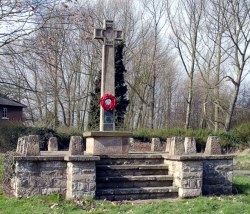
Budby War Memorial (above) 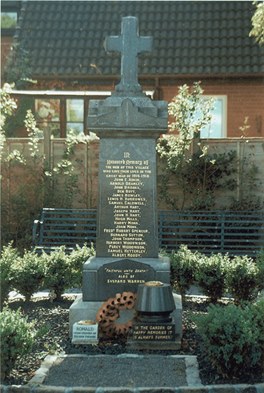
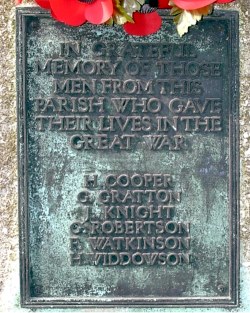 Budby War Memorial detail of commemorative plate (above) Hathern Memorial Cross (left)
|
|
Sergeant S4/085948 Joseph Spencer (Joe) Wild |
|
Royal Army Service Corps. Died of Pneumonia 20th November 1915, Aged 23. Buried Loughborough Cemetery 9/226
|
|
Joseph Spencer Wild, known as 'Joe', was born in Bury, Lancashire, in 1892, the son of Joseph Wild, a pork butcher, and Elizabeth Spencer Wild (née Mills). Joe's parents were married at Christchurch, Walmersley, Lancashire in 1890 and a year later were living at 357 Walmersley Road, Bury. Joe had a twin sister Florrie and an older brother Harry. What became of Joe's father is unknown but in 1900 his mother was remarried to John Whitworth Sacker, a widowed iron founder from Bury who had a young daughter Edith. By 1901 the family had moved to 69 Burder Street, Loughborough. In 1911 Joe was employed as a law clerk and the family were living at 14 Boyer Street. Joe's parents later moved to 39 Hudson Street. Joe enlisted as Private S4/085948 with the Royal Army Service Corps and served with Supply. He was promoted to Acting Corporal and then to Sergeant. He died of pneumonia on 20th November 1915, aged 23 and is buried in Loughborough Cemetery Grave 9/226. His funeral was reported as follows: 'Military honours were paid at the funeral, at Loughborough Cemetery, of Sergeant Joseph Spencer Wild, of the Army Service Corps. Deceased was the son of Mrs. Sacker and the late Mr. J.Wild, of 39 Hudson Street, Loughborough, and was 23 years of age. Before he enlisted he was in a good position in Leicester, and had previously done well at Loughborough Technical Institute, where he was a great favourite among the students. He had an illness while in camp at Aldershot, and came home on sick leave early, but very soon after severe pneumonia developed, and for several days he was unconscious, and died on Saturday. The mourners were: Mr. and Mrs. J. W. Sacker (step-father and mother), Mrs. F. James (sister), Mr. E. James (brother-in-law), Mr. and Mrs. T. Ward (cousins), Miss Rivington, and Mrs. Rivington. Mr. H. Miller and Miss Hart represented the office staff of Messrs, J. Marsh Ltd, (Leicester), where deceased was employed before joining the Army, and Mr. J. A. Martin (tutor) and Mr. H. H. Carpendale represented the advanced shorthand class at the Loughborough Technical Institute. The bearers were five sergeants and four corporals of the A.S.C. from Aldershot, under the command of Sergeant Major Ferris. The firing and bugle parties were from the Depot of the 17th Leicestershire Regiment at Glen Parva, and were under the command of Sergeant Manship. The coffin was covered by the Union Jack; on which was the late sergeant's headgear and belt. The Rev. F. W. Gostick and H. Hartley conducted the service, and after three volleys had been fired over the grave the "Last Post" was sounded. Wreaths were sent by the family, and floral tributes were also presented by his fellow clerks at Messrs, J. Marsh, Ltd, (Leicester), the clerical staff of the Labour Depot, A.S.C. Aldershot, and Mr. J. A. Martin and his shorthand friends.' |
|
Private 8/12156 Albert Wilkinson |
|
|
8th Bn, Leicestershire Regiment. Killed in Action 16th May 1916, Aged 23. Buried Bienvillers Military Cemetery, I. A. 88.
|
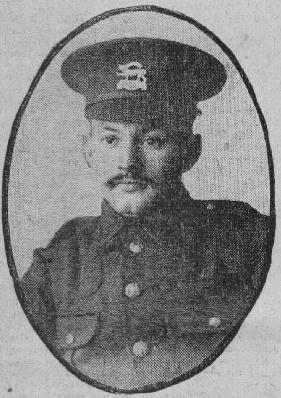 |
|
Albert Wilkinson was born in East Norton, Leicestershire, in 1893. He was son and only child of William Wilkinson, a farm labourer, and his wife Harriet (née Carter). His parents were married in the Melton Mowbray area in 1891. Albert's mother sadly died when Albert was two years old and his father's sister Eliza Ann Wilkinson came to look after the household. In 1901 the family home was at Wilsthorpe near Long Eaton and Albert's uncle Jesse Wilkinson had joined them. By 1911 Albert's father and aunt Eliza Ann had moved with Albert to 31 Albert Street, Loughborough. Albert was now working in the Despatch Office of the Empress Works. Albert's father and aunt Eliza Ann later moved to 98 Russell Street. Albert enlisted at Loughborough in 1914 and joined the 8th (Service) Battalion of the Leicestershire Regiment as Private 12156. He was initially sent to Aldershot for training and then to Shorncliffe in Kent at the end of February 1915. In April 1915 Albert's battalion became part of the newly established 37th Division of the Second New Army and the Division began to concentrate on Salisbury Plain. On 25th June the units were inspected by King George V at Sidbury Hill. On 22nd July 1915 the Division began to cross the English Channel and Albert travelled to France on 29th July 1915. The 8th Battalion then moved via Watten, Houlle, St. Omer, Eecke and Dranoutre to Wulverghem and Berles-au-Bois, a short distance from the front line. In the months that followed the 8th Battalion did tours in the trenches, alternating with the 6th Leicesters who relieved them. In April 1916 the 8th Leicesters moved to the Doullens area for six weeks for cleaning up, resting and training. In mid-May the 8th Leicesters returned once more to the trenches in the Bienvillers-Bailleulmont sector. It was here that Albert was killed in action by the explosion of an enemy trench mortar bomb on 16th May 1916, aged 23. He is buried at Bienvillers Military Cemetery, Pas de Calais, Grave I. A. 88. The same bomb also caused the death of Albert's friend and comrade, Private Tom Hudson of Queen's Road, from Hurst's boot shop, Church Gate. Albert and Tom were buried in adjacent graves. Albert's Captain wrote: "He was a universal favourite especially on account of his very fine example, his splendid cheerfulness and courage. I know his sterling worth, for he has been with me since the birth of the battalion, and I have never had the slightest reason to find fault with him. He was a very good soldier indeed, and always ready to volunteer for anything, and had it not been for his diminutive size he would most probably been a sergeant." After the funeral the Chaplain also sent a comforting message which said that Wilkinson, although small in height, was strong and was an expert bomber. He had been at the Empress Works for eight years, and was thoroughly liked by all from the workmen to the management. He was very keen on improving his education. Sergeant J. A. Frake, a Loughborough man, in his letter of condolence said: "He was loved and respected by all". |
|
|
Captain Alban Noel Wills |
|
|
Died of Wounds 7th March 1918, Aged 29. Buried Lijssenthoek Military Cemetery, Poperinghe, XXVII. E. 21. |
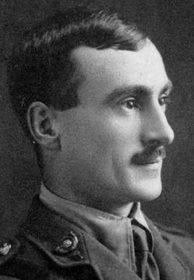 |
|
Alban Noel Wills was born in Loughborough in the summer of 1888 and baptised at Emmanuel Church, Loughborough, on 27th January 1889. He was the son of Henry Wills and his wife Katherine Ellen (née Jones) who were married at St. Andrew's Church, Walcot, Somerset, on 27th July 1875. Alban's father was a printer, bookseller and stationer in Loughborough. By the time Alban was born the family had moved from 4-5 Market Place, Loughborough, to Forest Road. Alban had one brother Edward and two sisters Winifred and Dorothy. His parents later moved to 8 Cleveland Place West, Bath. with a second residence at Colwyn Bay.
Alban qualified as a solicitor and was admitted to The Law Society in 1909. He moved to Liverpool where he was in practice and rented two rooms in a boarding house at 5 Ducie Street, Princes Park. Shortly afterwards he relocated to Doncaster where he rented two rooms in St Mary's Rd and had his office in the High Street in the town centre. He had connections with Doncaster Rugby Union Football Club, (now the Doncaster Knights). Alban was also the secretary of the Doncaster Volunteer Training Corps in its early days and put in a great deal of work in connection with the linking of the Corps with the Central Association and its eventual establishment as a recognised unit of the Home defence forces. In 1914 Alban went to the Royal Military College, Sandhurst, to prepare for a commission and his commission as a 2nd Lieutenant was gazetted on 3rd June 1915. He was appointed to the 1/5th Battalion of the King's Own Yorkshire Light Infantry, a Territorial unit, and he joined the battalion at Puchevillers on 11th March 1915. On 30th March the battalion marched to billets at Rubempre for training until 3rd April. On 4th April they marched to Talmas where training continued until 22nd May with special emphasis on infantry assault, rapid and systematic wiring, tactical schemes and wood and village fighting. On 23rd May the battalion marched to Hedauville and provided working parties for the Royal Engineers burying cables between Engelbelmer and Martinsart until 8th June. After eleven days under canvas at Aveluy Wood the battalion then returned to Hedauville before marching to Harponville on 22nd June. On 27th June the battalion proceeded to Senlis and on 28th June to Contay. On 30th June they proceeded to the assembly trenches at Aveluy Wood. On 1st July, the first day of the Somme Offensive, the battalion was held ready to support the attack on Thiepval but was not required. On 2nd July they were ordered to take over the line in the Thiepval Wood sector and over the next five days made several attacks on the German trenches. Relived on 8th July the battalion had a week's rest at Martinsart Wood. Two further trench tours followed, one at Martinsart Wood and another at Authville and the Leipzig Salient during which the battalion was heavily shelled and suffered a number of casualties. The battalion was then withdrawn to South Bluff, Authville. In early August the battalion was based at Aveluy Wood and Hedauville and provided working parties for digging the front line. This was followed by a break at Puchevillers, after which they continued with working parties at Aveluy Wood. The battalion returned to the front line opposite Thiepval at Authville until 4th September. It then went into support at Ross Castle before returning to the line on 19th September. Between 20th and 26th September the battalion moved via Hedauville, Raincheval and Humbercamps for training until 2nd October. A six-day trench tour at Hannescamps lasted until 9th October and from 10th-24the October the battalion was in training at Warluzel and Souastre. The rest of October was spent in the line facing Hebuterne. During November there were trench tours at Hebuterne and Bienvillers and five days' training at Humbercamps. On 26th November the battalion moved to Pommier for working parties until 5th December when they marched into reserve at St. Amand. The rest of December and 1st - 5th January 1917 was spent training at Warluzel. During 6th January and 18th February 1917 there were four trench tours opposite Blairville and at Bretencourt, with breaks at Bailleulval, Basseux and Bellacourt. On 23rd February the battalion began a ten-day march via Gaudiempré, Ivergny, Bonnières, Siracourt, Pernes and St. Floris to Vieille Chapelle. During March, April, May and early June the battalion completed nine trench tours at Neuve Chapelle with breaks in brigade support and reserve at Riez Bailleul and Pont du Hem. In April one week was also devoted to sports and a performance by the battalion's troupe the 'Koylis'. In June two successful raids were also made on the enemy trenches in spite of strong enemy opposition. June ended with four days' training at Fosse. Training then continued at Croix Barbée and La Gorgue. On 1st July Alban was promoted to the rank of Lieutenant. On 11th July the battalion marched to Vendin-lès-Béthune and on the following day entrained at Béthune for Dunkerque. On arrival they marched to the Canal Docks and spent the night on barges. On 14th July they moved by barge up the canal to Zuydcoote for duty on the coastal defence. One day was spent on the sands practising an attack and several men were stung by jellyfish while bathing. On 16th they moved to Coxyde and on 17th took over the trenches in the Lombartzyde sector at Nieuport. Over the next six days the battalion was severely attacked by the enemy causing 329 casualties including 124 men poisoned by gas. It seems that Alban was slightly wounded at this point. Alban rejoined the battalion on 27th October 1917 at Steenvoorde on the Ypres Salient. From 28th October to 19th November the battalion was training at Steenvoorde and Dickebusch. On 20th November they moved to deep dugouts at Halfway House for four days on working parties before going to the Canal Bank at Ypres for refitting. A front line trench tour near Molenaavelsthoek followed until 1st December. December included salvage and wiring work in the Ypres and Potijze areas. Christmas was spent at Vancouver Camp, Reninghelst, where the battalion enjoyed a concert parties by the 'Tykes' and the 'Koylis'. The battalion was back in the front line at Zonnebeke on 29th December and remained at the front and support lines until 10th January 1918. The remainder of January was mostly spent at Hondeghem, resting, training and refitting. At the end of January the battalion, which had moved by train to Reninghelst, was broken up. Alban was promoted to Captain and transferred to the 1/4th Battalion of the King's Own Yorkshire Light Infantry. The war diary for the 1/4th Battalion for February 1918 has been lost but on 1st March the battalion was training in a camp at Belgian Chateau. On 2nd March the battalion took over part of the front at Ypres. On 4th March 1918 Alban was badly wounded. He was taken to a Canadian casualty clearing station suffering from a compound fracture of his left thigh, haemorrhage and exposure. He died from his wounds, aged 29, on 7th March 1918. The Doncaster Chronicle of 22nd March 1918 reported his story under the title 'The late Captain A. N. Willis The Manner of his Death. Cheerful to the End'. The article included the transcript of a letter sent to his family from the Sister who was with him at the Canadian casualty clearing station to which he was sent. She wrote 'He was brought here at 3am on the 5th of March in a very low condition, the result of a compound fracture of the left thigh, haemorrhage and exposure and was quite pulseless on arrival. We succeeded in resuscitating him sufficiently to go to the operating room, where he received a blood transfusion of several ounces and his wounds were cleaned and dressed. His condition was so much improved that we all felt very hopeful and he was so bright and brave through it all. Early this morning (the 6th) it became evident that blood poisoning was setting in, and at 11pm it was decided that immediate amputation was necessary as the fracture was just below the hip. When the doctor told him he was quite reconciled and said he quite expected it might have to come off. He had already asked me when he came from his first operation if it was his leg or a camouflage one as it felt numb. 3am Your son has just passed away quietly, the shock of the operation in his artificially stimulated condition was too much for his heart and he slept peacefully away without recovering consciousness. Please accept, from a complete stranger, my heartfelt sympathy in your bereavement. His sweet, serene cheerfulness and bright disposition even in that short time, endeared him to all of us and we can realise how great indeed is your loss, but you can rest assured that he received every care and attention and nothing was left undone which might have aided his recovery.' The sister added that the interment took place in a military cemetery near Poperinghe and each grave was marked with a simple cross. The Chaplain at the station wrote a letter similarly testifying to Alban's cheerfulness and courage, adding that he had mentioned his father and mother and that 'it will always be a comfort to you to know that he was brave to the last'. Alban was buried in Lijssenthoek Military Cemetery, Poperinghe, Grave XXVII. E. 21. |
|
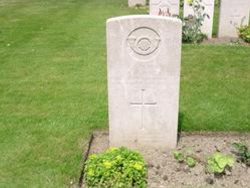 |
|
|
Private 7062 Arthur Wilson |
|
|
Private 7062 1/10th (Scottish) Bn, The King's (Liverpool Regiment). Later renumbered as 357969 Killed in Action 7th January 1917, Aged 22. Buried Vlamertinghe Military Cemetery V. D. 3.
|
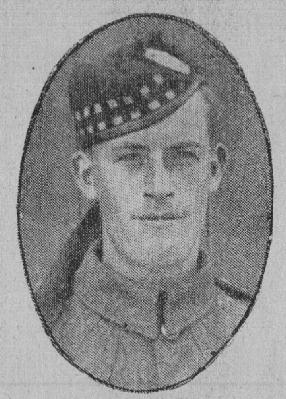 |
|
Arthur Wilson was born in 1895 at Grovehill Road, Beverley, Yorkshire. He was the youngest child of Thomas Wilson and his wife Margaret (née Burgess) who were married in Beverley in 1880. Arthur's father was an agricultural machine minder and Arthur had three brothers Tom, Fred and George, and one sister Lydia. By 1901 the Wilson family had moved to 14 Curzon Street, Sculcoates, Hull. In 1911 Arthur, aged sixteen, was living with his married sister Lydia (Mrs. Arthur Simpson) and family at 22 Charles Street, Loughborough, and was employed as a hosiery packer by Messrs. J. and R. Morley. Arthur's mother, meanwhile, had taken a position as housekeeper to Mr. Sylvester Hanson, a grocer and insurance agent, at 3 Providence Row, Hull. The whereabouts of Arthur's father at this time are unknown.
Between 1911 and 1914 Arthur appears to have moved to Everton, Liverpool. He enlisted with the King's (Liverpool Regiment) as Private 7062 (later Private 357969} and joined the 1/10th (Scottish) Battalion, a Territorial Force. His service record has not survived but it appears that he enlisted towards the end of 1915 and was not posted to France until 1916. On New Year's Day 1916 the 1/10th Battalion was resting in Reninghelst south-west of Ypres but on 8th January transferred to Bailleul and entrained for Pont Rémy. From there they marched to Heucourt-Croquoison south of Abbeville in Picardy where they remained until 4th February and received training in physical drill and bayonet fighting, musketry, range practice, route marching and French digging. The Army's 55th Division, to which the battalion now belonged, was inspected at Hallencourt on 29th January. On 4th February they moved to Prouville where training continued until 12th February when they went into the trenches at Bellacourt south-west of Arras. Trench tours alternated with time in billets at Grosville and La Herlière. On 8th March the battalion moved to Saulty and continued with trench tours until the end of June. On 12th-13th July they moved to a position in front of Agny village, the battalion being in Brigade Reserve. On 18th July they were ordered to move to Bernaville and in late July they took over a section of front line near the village of Guillemont, Somme. They were in action at the Battle of Guillemont (3rd-6th September), the Battle of Ginchy (9th September) and the Battle of Flers-Courcelette (15th-22nd September). After Courcelette the battalion bivouacked near Pommiers Redoubt on the Montauban-Mametz Road, then moved to billets in Ribemont and on 30th September entrained at Méricourt for Longpré. From there they marched via Pont-Remy to Abbeville where, on 2nd October, they entrained for Proven, Belgium. From 'K Camp', Poperinghe, they moved to dugouts on the Canal Bank, Ypres, and then to the front-line trenches at Wieltze. For the rest of October until mid-November they repaired trenches at Wieltze and Elverdinghe Chateau amid enemy shelling and provided cable-burying parties at Canal Bank, with periods of respite at Brandhoek. On 29th November a successful raid on the enemy was made from Canal Bank. Between 2nd and 18th December the battalion was in the front-line at St. Jean, in the Wieltze sector, improving the barbed wire entanglements and was again heavily shelled. Following this the battalion was sent to 'C Camp', Brandhoek, for training, cleaning up and refitting. They returned to the trenches near St. Jean on 28th December, and it was here on 7th January 1917 that Arthur was killed aged 22. Arthur's platoon sergeant wrote that he was out wiring in the front of our trenches when a shell dropped close to him, death being instantaneous. He added 'I have been his platoon sergeant since last October, and have always found him very reliable and a fearless soldier, ever ready and willing to do whatever he was called upon to undertake. His death is a personal loss to me and the other members of the platoon. It may be some little consolation to you to know that he died a noble death, and you have the sympathy of the whole of this platoon'. Arthur was buried in Vlamertinghe Military Cemetery, Grave V. D. 3. |
|
|
Private 9924 Frederick Wilson |
|
|
2nd Bn, Leicestershire Regiment. Died of Disease Mesopotamia 28th September 1916, Aged 21. Buried Amara War Cemetery Iraq, XIV. F. 5.
|
|
|
Frederick Wilson, known to his family and friends as 'Fred', was born in Shepshed in 1895, the son of Edgar Wilson and his wife Elizabeth (née Higgott Mee) who were married in 1892 in the Loughborough area. Fred's father started out as a brickyard labourer but later became a stone quarry sledger. Fred had four brothers Charles, Joseph, Thomas and Leonard and three sisters Beatrice, Doris and Dulcie. Another sibling had died young. In 1901 the family lived in Britannia Street and in 1911 in Hallcroft, both in Shepshed. Between 1911 and 1914 they moved to 3 Hartington Street, Loughborough. By 1911 Fred, aged 15, had become a farm labourer, but by 1914 he had become a fitter. Fred enlisted at Loughborough on 6th August 1914 and joined the Leicestershire Regiment as Private 9924. He joined the 3rd (Reserve) Battalion and was sent for training as a recruit at Portsmouth. By May 1915 he had been posted to Hull for duty with the Humber Garrison. At some point unknown in 1915 Fred was posted to the 2nd Battalion of the Leicestershire Regiment which in late November/early December 1915 left France for Basra, Mesopotamia where Britain was fighting Turkish forces allied to the Germans. From Basra Fred travelled by boat up the River Tigris to Ali Gharbi, 150 miles south-east of Baghdad. In Mesopotamia General Townshend and his troops were under siege at Kut. On January 4th 1916 General Aylmer's leading troops, under Major General Younghusband, began to advance from Ali Gharbi towards Sheikh Sa'ad, with the intention of relieving General Townshend at Kut. The Turkish commander Nur-Ur-Din had, however, effectively blocked any progress by placing approximately 22,500 troops and 72 guns on both banks of the Tigris at Sheikh Sa'ad, about 16 miles downstream from Kut. General Aylmer therefore ordered an attack on the enemy and very heavy fighting ensued on 7th January 1916 at the Battle of Sheikh Sa'ad. Fred was wounded in action during operations between 6th and 8th January 1916. In March an attack on the Turk-held Dujaila Redoubt, at the extreme outer edge of Es Sinn, failed. On 5th April there was a heavy bombardment on the enemy's position on both banks of the Tigris and the enemy retired to Fallahiya and then Sannaiyat. The 2nd Leicesters marched at night in massed formation on the enemy's new position but came under withering fire from the enemy. During the remainder of April further attempts were made to dislodge the enemy from their position at Sannaiyat but without any success. After repeated attempts to break through to Kut, General Townshend was compelled to surrender on 29th April 1916. His force in Kut-al-Amara of 13,164 soldiers became captives of the Ottomans. The British viewed the loss of Kut as a humiliating defeat and further attempts to advance in Mesopotamia were ordered by the politicians on the British War Committee on 18th September 1916. It was about this time that Fred became ill in Mesopotamia. He died at Sheikh Sa'ad, probably on a hospital ship on the Tigris on the way to a field hospital at Basra, on 28th September 1916, aged 21. Fred was buried in buried Amara War Cemetery, Iraq, Grave XIV. F. 5. He is remembered on the Carillon and also on the gravestone of his brother Joseph in Loughborough Cemetery. Joseph, aged 18, was fatally kicked in the heart by a horse in Cotes in 1919. |
|
|
Private 13198 Joseph Henry Wood |
|
|
8th Bn, Leicestershire Regiment. Killed in Action 3rd February 1916, Aged 20. Buried Berles-au-Bois Churchyard Extension, B. 6.
|
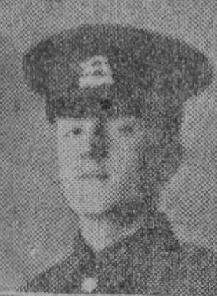 |
|
Joseph Henry Steele, afterwards Wood, was born in Mansfield, Nottiinghamshire, in 1895, the son of Lily Steele. In 1900 his mother married John William Wood, a hosiery fitter, in Loughborough in 1900 and Joseph Henry was thereafter known by the surname of Wood. In 1900 his mother married John William Wood, a hosiery fitter, in
Loughborough in 1900 and Joseph Henry was thereafter known by the surname of Wood. In
1901 John and Lily Wood were living at 31 Cobden Street, Loughborough, with Joseph and
John William junior. By 1911 the family had moved to 61 Clarence Street, Loughborough, and
Joseph now had three half-brothers John, Edward and Walter, and three half-sisters Gladys,
Gwendoline and Jessie. Another half-brother Benjamin was born in 1914. Joseph now had
employment as a khaki hand with N.M.C. When war broke out both Joseph and his step-father John William enlisted. Joseph became Private 13198 in the 8th Battalion of the Leicestershire Regiment and his step-father, who had previously served with the volunteers, joined the 3rd Battalion of the same regiment. Joseph's battalion was raised at Leicester as part of Kitchener's Third New Army and joined the 23rd Division as Divisional Troops. The units of the Division began to assemble in Hampshire and in December moved into Aldershot and Ewshott. In February 1915 another move was made to Shorncliffe in Kent. In April 1915 the 8th Battalion transferred to the 37th Division and a Divisional HQ was established at Andover. The troops then concentrated on Salisbury Plain and on 25th June were inspected by King George V at Sidbury Hill. Fred went with his battalion from Folkestone to France on 29th July 1915, where they initially concentrated near Tilques. In January 1916 Joseph's battalion was in the Arras area of the Pas de Calais, clearing out and repairing trenches around Never Ending Street and Nasty Lane while the enemy fired salvoes of high explosives and whizz-bangs at them. Joseph was killed in action while on sentry duty in the village of Berles-au-Bois, where he was billeted, on 3rd February 1916, aged 20. He was hit by a German high explosive shell and when found was still grasping his rifle and bayonet, game to the last. He was buried in Berles-au-Bois Churchyard Extension, Grave B.6, by the Reverend S. Magor, Wesleyan chaplain attached to the 9th Leicesters. By 1919 the Wood family had moved to 11 Gordon Street, Loughborough. After the war ended Joseph's half-brother John enlisted with the Leicestershire Regiment, transferring to the Sherwood Foresters, and his half-brother Edward enlisted with the North Staffordshire Regiment, transferring to the Leicestershire Regiment. |
|
|
Private 11811 George Thomas Woolley |
|
|
7th Bn, Leicestershire Regiment. Killed in Action 14th July 1916, Aged 23. Buried Flatiron Copse, Mametz, Somme XI. J. I.
|
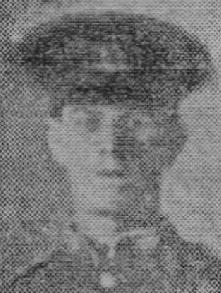 |
|
George Thomas Woolley was born in Kegworth in 1892, the son of George Woolley a farm labourer and his wife Emma (née Highton) who were married in the Loughborough registration district in 1880. George Thomas had two brothers Wilfred and Charles and five sisters Eunice, Sarah, Beatrice, Pollie and Maggie. In 1891 the family lived in The Square, Main Street, Long Whatton. By 1901 they had moved to Draper's Yard, Long Whatton. George Thomas's sister Maggie, aged 8, died in 1906 and his mother Emma and his sister Sarah both died in 1909. In 1911 his father was living with Pollie at Golden Square, Hathern. George Thomas, meanwhile, was lodging with the Cotton family at Whatton Fields and working for farmer Herbert Cotton as a herder. After George Thomas's sisters Pollie aged 16 and Beatrice aged 22 also died in 1912 his father appears to have moved to Thorpe Acre, Loughborough.
George Thomas enlisted soon after the First World War broke out and joined the 7th (Service) Battalion of the Leicestershire Regiment as Private 11811. On enlistment he would have been sent to Aldershot, Hampshire, for training. In April 1915 the 7th Battalion became part of the 37th Division of the Army and concentrated at Cholderton on Salisbury Plain. On 25th June the 37th Division was inspected by King George V at Sidbury Hill. George Thomas went to France on 29th July 1915 where his battalion gathered with the 37th Division at Tilques, near St. Omer. In September the 7th Battalion was sent to the area of Berles-au-Bois, south-west of Arras. The battalion remained in this area around Bienvillers and Bailleulmont until April 1916 and was engaged in localised operations seeking a tactical advantage. When not in the trenches being subjected to enemy shelling the 7th Leicesters received intensive training in bombing, Lewis gunnery, visual signalling and a host of other activities. In April 1916 they were moved to the Doullens area and formed working parties to cut down trees and prepare brushwood for the front line as well as preparing the support trenches in the area. In May they worked on building a new railway line between Le Bret and Bienvillers-au-Bois. Towards the end of May the battalion returned to the trenches in the Bienvillers-Bailleulmont area. At the beginning of July the 7th Battalion moved on to the Somme. They were at Fricourt on 13th July and at Mametz Wood and in the attack on Bazentin-le-Petit on 14th July. George Thomas was killed in action on 14th July 1915, aged 23. He is buried at Flatiron Copse, Mametz, Somme, Grave XI.J.1. His only surviving sister Eunice had predeceased him by a couple of months. |
|
|
Private 44041 John Woolridge |
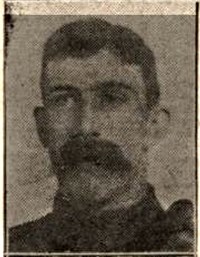
9th Bn, King's Own Yorkshire Light Infantry.
Formerly 164023 R.H. & R.F.A. Killed in Action 9th April 1917, Aged 33. Buried Wancourt British Cemetery, V. G. 26.
|
|
John Woolridge was born in Aldershot in 1884, the son of Lewis Woolridge and Emma Fanny Woolridge (née Friday) who were married on 3rd October 1883 at the Church of St. Michael the Archangel, Aldershot, Hampshire. At birth he was registered as 'Johnny Woolridge' but all other official documents use the name 'John Woolridge'. John's father was a Driver in the Royal Artillery and in 1891 the Woolridge family was living at Shorncliffe Camp, Cheriton, Kent. John had four sisters Winifred, Aileen, Dorothy and Amy. By 1901 John's father had left the Army and was working on a farm and the family was living in Upper Street, Okeford Fitzpaine, Dorset. John, now aged 17, was a butter roller at the Hillview Dairies in Okeford Fitzpaine. On 11th April 1907 John married Rose Upshall at St. Andrew's Church, Okeford Fitzpaine, and in 1911 John and Rose were living in Okeford Fitzpaine with Rose's widowed father, a farm labourer. John was now working as a blender at Hillview Dairies and Rose was a glove maker. Rose's father died in the early summer of 1914 and when John enlisted at Sturminster Newton in late 1915 Rose moved to 111 Queen's Road, Loughborough. Rose's sister Isabella and her husband Henry Short ran a lodging house at 35 The Rushes and Rose's brother Charles also worked there as a groom. John initially joined the Royal Artillery as Private 164023 but at some point transferred to the 9th (Service) Battalion of the King's Own Yorkshire Light Infantry (KOYLI) as Private 44041. His date of transfer is unknown as his service record has not survived. His date of entry into France is also unknown but it was no earlier than 1916 as he did not qualify for the 1914/15 Star Medal. In 1916 the 9th Battalion of KOYLI was in action in the Battles of The Somme, including the Battle of Morval in which the Division captured Geudecourt. According to the battalion's war diary substantial reinforcements of ordinary ranks joined the battalion in late September and late December 1916 and in January 1917. John is likely to have been in one of these groups. In early October 1916 the battalion was in training at Buigny l'Abbé and Chocques before going into the trenches in the Cambrin Sector where they were heavily bombarded by the enemy. They also provided assistance to Royal Engineers tunnelling parties. Respite from the trenches was in Annequin and Béthune. On 6th December the battalion marched to billets in Philosophe and worked on dugouts before going into the support trenches in the Hohenzollern Sector. On 28th December the battalion marched to Noeux-les-Mines. All of January 1917 was spent training: route marches, tactical exercises and musketry. At the end of the month the battalion entrained for Esquelbecq and marched to Ledringhem where training continued and there were also working parties with the Royal Engineers on the railway west of Poperinghe. In mid-February the battalion moved to Annequin and went back into the trenches in the Cambrin Sector. In early March the battalion marched via Béthune, Esqueldecq and Séricourt to Lucheux where they spent nine days on attack practice. Further moves followed to Berles-au-Bois, Adinfer and Bosieux-au-Mont. On 9th April 1917 the battalion made an assault on the Hindenburg Line which failed owing to misplaced artillery preparation. Eight officers and 176 ordinary ranks were killed, including John Woolridge. John was 33 when he died. He was buried at Wancourt British Cemetery, Grave V. G. 26 and is commemorated on the Okeford Fitzpaine War Memorial, Dorset. |

